Are you planning a 2-week Kenya itinerary and want to ensure you make it your dream safari holiday?
Having spent countless hours on safaris across Kenya, I wrote this guide to help you make the most of your trip and avoid many of my mistakes!
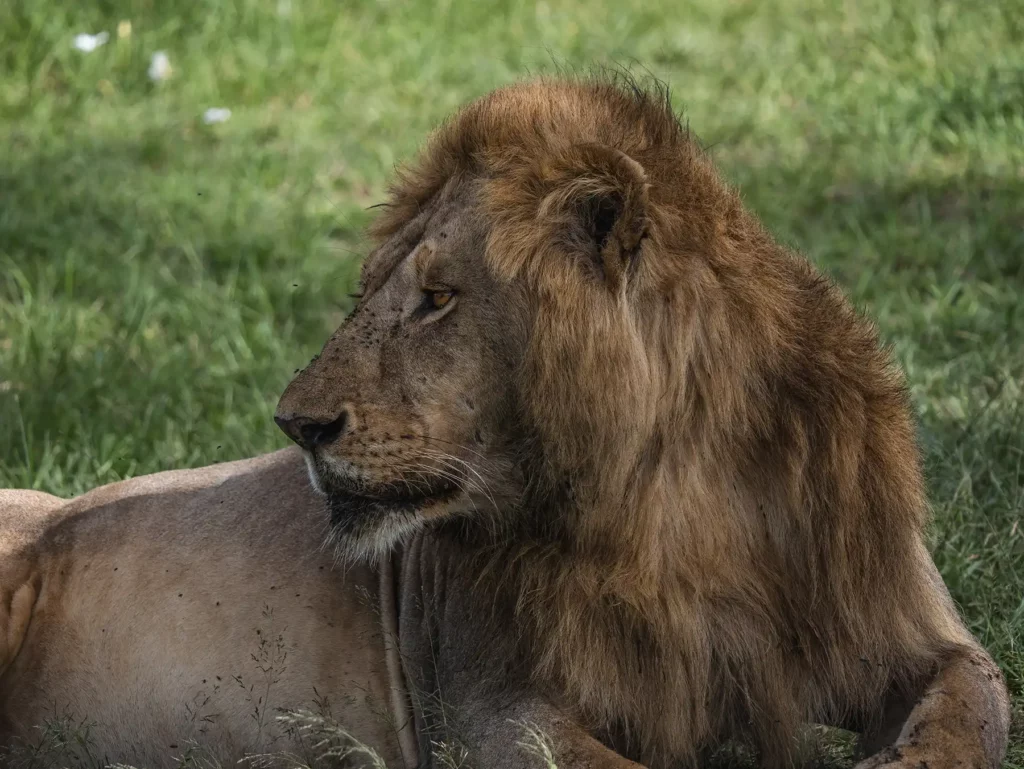
It’s no surprise that Kenya is one of Africa’s most popular safari destinations. It’s a diverse country in every sense, from the wildlife and landscapes to the culture.
I’ll certainly never forget seeing big cats hunting on the vast plains of the Maasai Mara or the huge elephant herds marching across Amboseli with Mount Kilimanjaro towering in the distance.
Having travelled around Kenya myself, I know first-hand how exhausting the long distances and drives can be, so factoring rest into your itinerary will help you make the most of every moment.
That’s why I’ve made sure this itinerary includes the perfect balance of highlights, hidden gems, and some much-needed downtime in optimal locations!
Alternatively, if you’d prefer to combine your safari trip with a second destination, you can view my 14-day Tanzania and Kenya itinerary.
In this guide, I’m going to share the ultimate 2-week Kenya safari itinerary. My goal is to cover any questions you might have about planning the perfect trip to Kenya, including costs, finding the perfect tour operator, and all my tried-and-tested tips and tricks to ensure your trip goes smoothly.
Read on to take the first step towards planning your dream safari holiday!

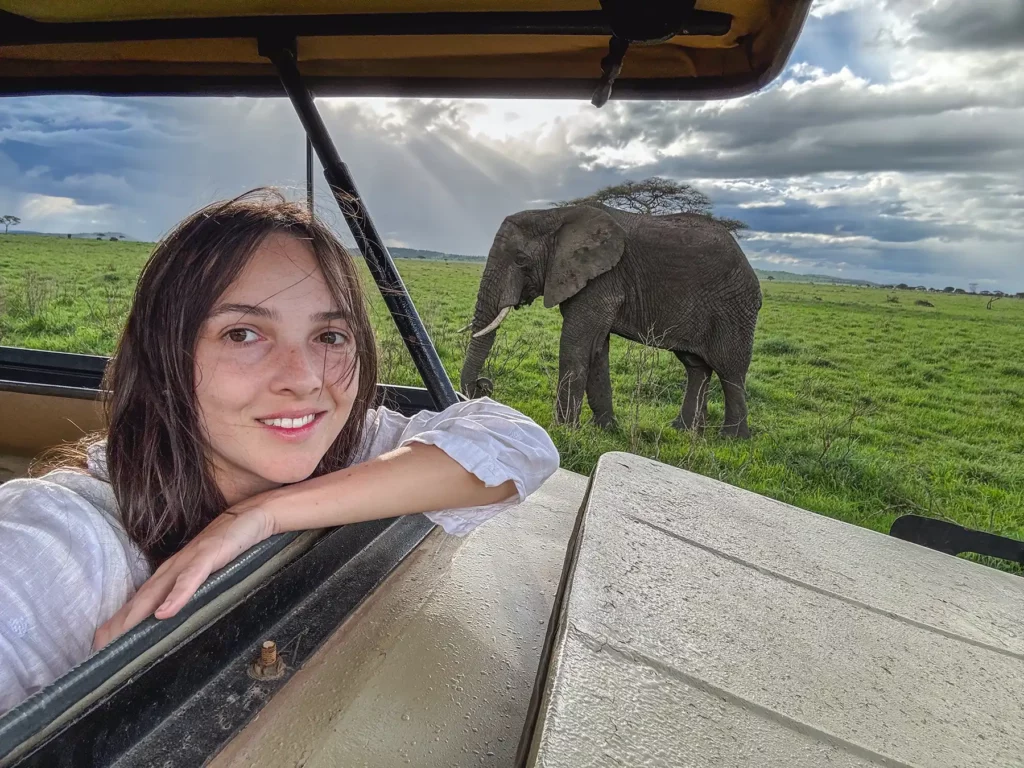
Embark on the Safari of Your Dreams
Save time and ensure an incredible safari experience by getting quotes from my recommended local safari companies
I’m here to make booking your perfect safari quick, easy and risk-free.
Join the rapidly growing tribe of over 1,000 travellers who’ve booked their dream safari using my insider tips and recommendations.

It takes under 60 seconds to fill out the form and in under 48 hours you will receive multiple, no-obligation proposals from my favourite local tour operators with glowing online reviews.
Get your free no-obligation safari quotes and my top safari tips and recommendations
2-Week Kenya Itinerary Map
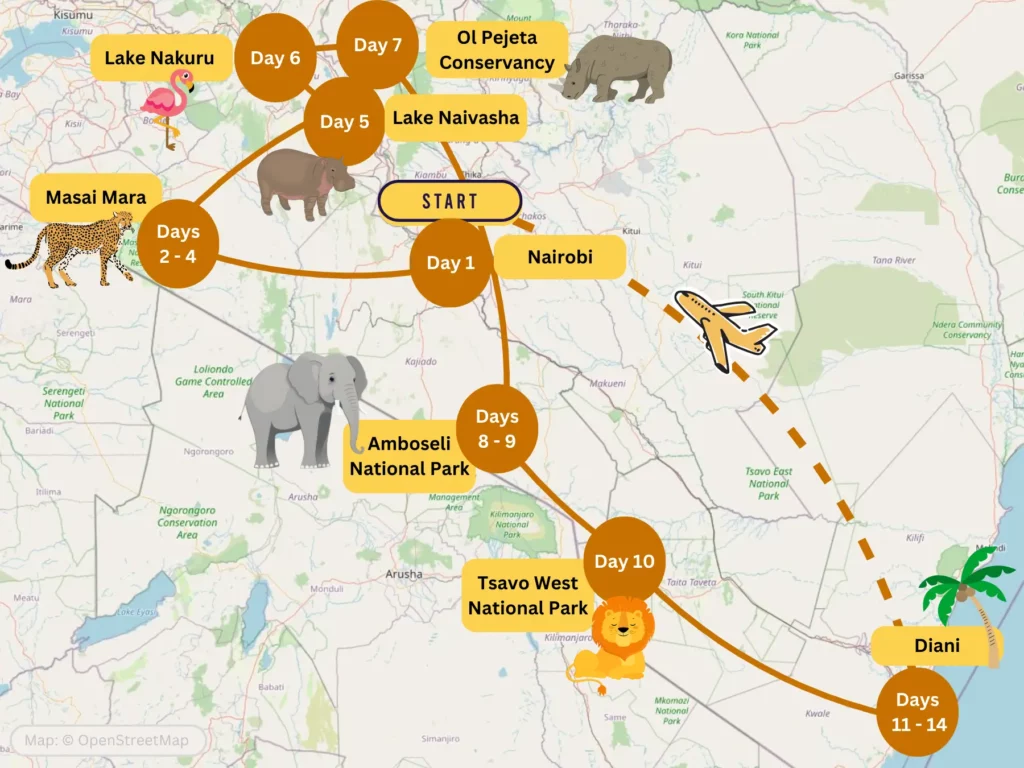
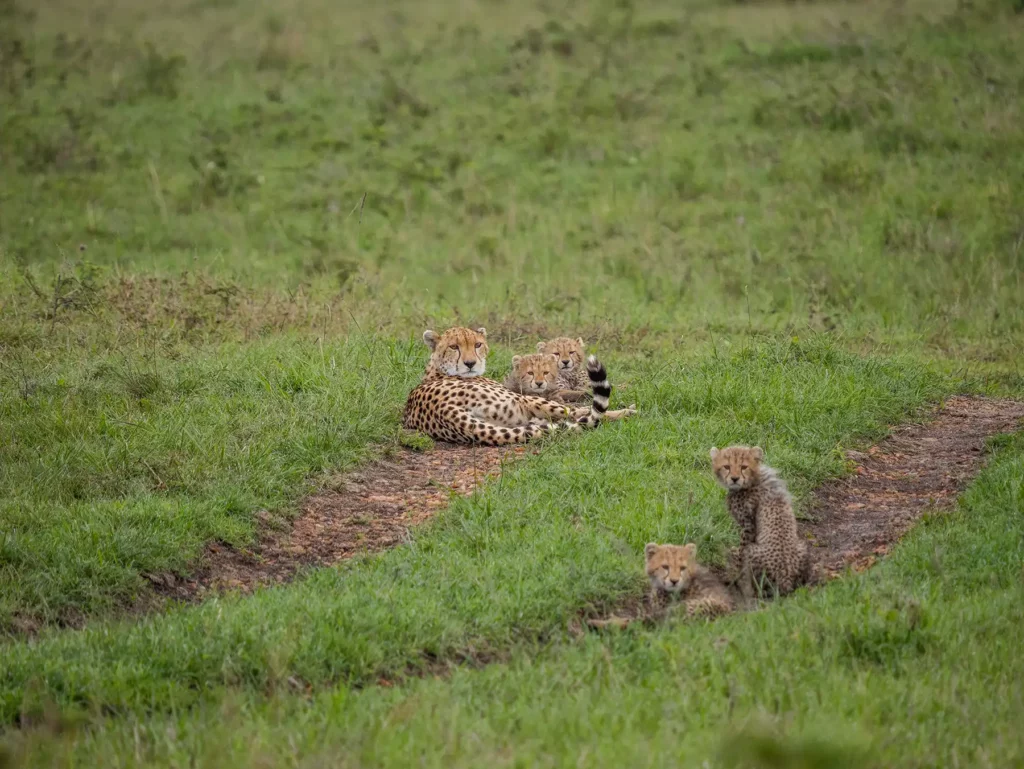
Why Go on Safari in Kenya?
Home to 23 national parks and game reserves, Kenya is often considered to be one of the best places to go on safari in Africa due to the enormous number of animals living here.
The country also features hugely diverse landscapes, from sweeping savannahs to soaring mountains, providing an ideal backdrop for viewing some of the world’s most magnificent wildlife.
The Maasai Mara, Kenya’s most beloved national reserve, boasts large populations of elephants, lions, African buffalo, rhinos, and cheetahs, along with hundreds of other animal and bird species.
Kenya’s Masai Mara is part of the same ecosystem as Tanzania’s Serengeti National Park.

Amboseli National Park is famous for its great elephant herds (known as Big Tuskers) and sweeping views of Tanzania’s Mount Kilimanjaro.
Tsavo is Kenya’s biggest park and one of the world’s biggest game sanctuaries, while Lake Nakuru is known for being a bird paradise.
Besides the amazing wildlife and scenery, it’s also really easy to get to Kenya (relatively speaking, at least!). Nairobi is one of the busiest airports in Africa, meaning you can take a direct flight to Kenya’s capital from cities across North America and Africa.
Nairobi Airport also serves as a transport hub for the region, making it easy to book an onward flight to another destination in Africa or towards the Indian Ocean.
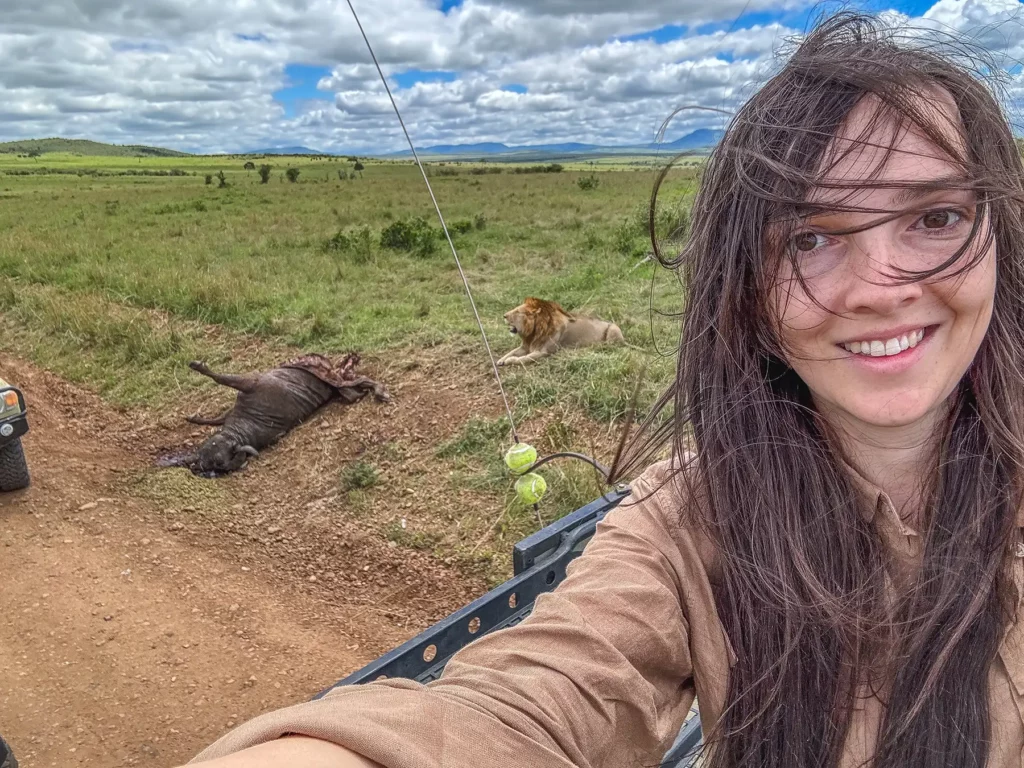
How to Book Your Kenya Safari
Planning a Kenya safari vacation can seem really daunting at first. Between the distances covered, the ruggedness of the landscape, and the sheer amount of choices on where to go, it’s understandable if you feel confused when planning your trip.
Don’t worry, though – I am here to help!
You can get quotes from the same local tour companies I use to organise my own trips here: Safaris By Ella
The first step is choosing between the two main options for going on safari; you can either choose a self-driving safari (where you rent a vehicle and arrange your own accommodation) or you can book a guided safari tour where everything is arranged for you.
If you opt for a guided safari, you can book these with either a local tour operator, International operator or directly with the accommodation. We’ll go into the pros and cons of each below.
You can also choose either a private or group tour. Unless you are travelling on a tight budget, I recommend booking a private safari. Private safaris allow you to have a more flexible schedule and means you won’t be jostling with a bunch of strangers to get the best angle for a photo.
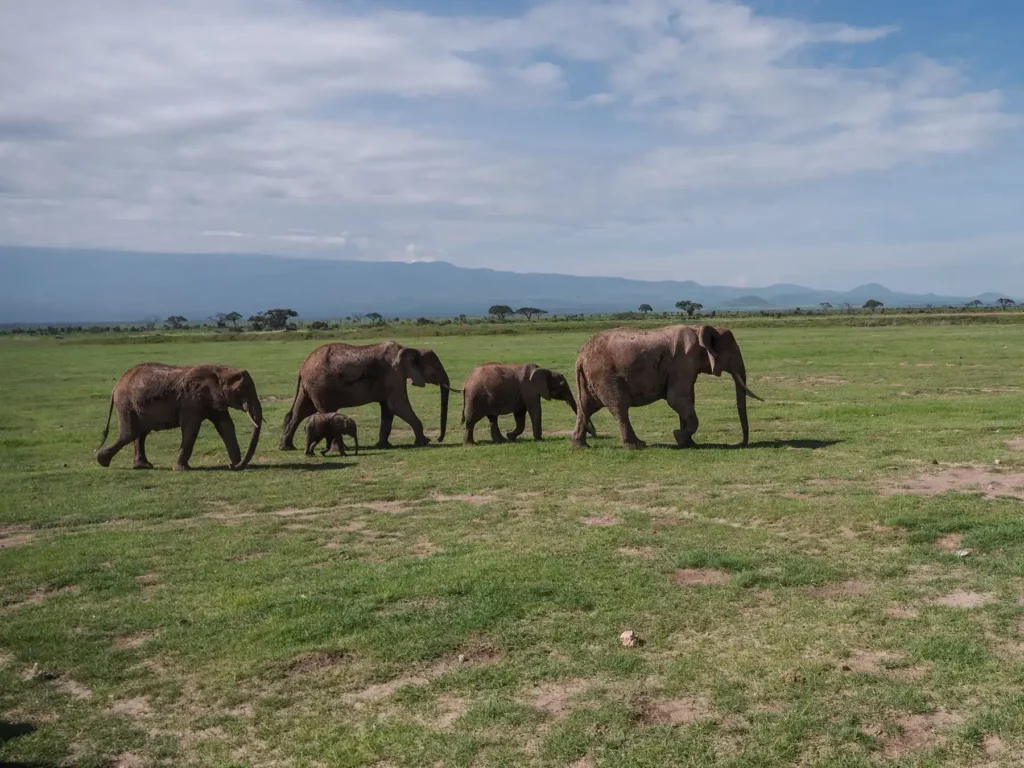
Option 1: Self-Drive Safari
Some of Kenya’s nature reserves and national parks allow visitors to drive themselves through the park.
At first glance, self-drive safaris are a great way to save money and can offer a ton of flexibility. You simply need to rent a car, buy your park tickets, and head out to explore, right?
Well, kind of. While it may seem like a great idea, there are some pros and cons to self-driving that you really need to think about before you make your final decision.
The first, and most important, thing that you want to think about is how good you are at spotting animals. Be honest with yourself there. Unless you are a naturalist, it may be very difficult to spot the animals, which is likely the biggest reason for coming on a safari in the first place!
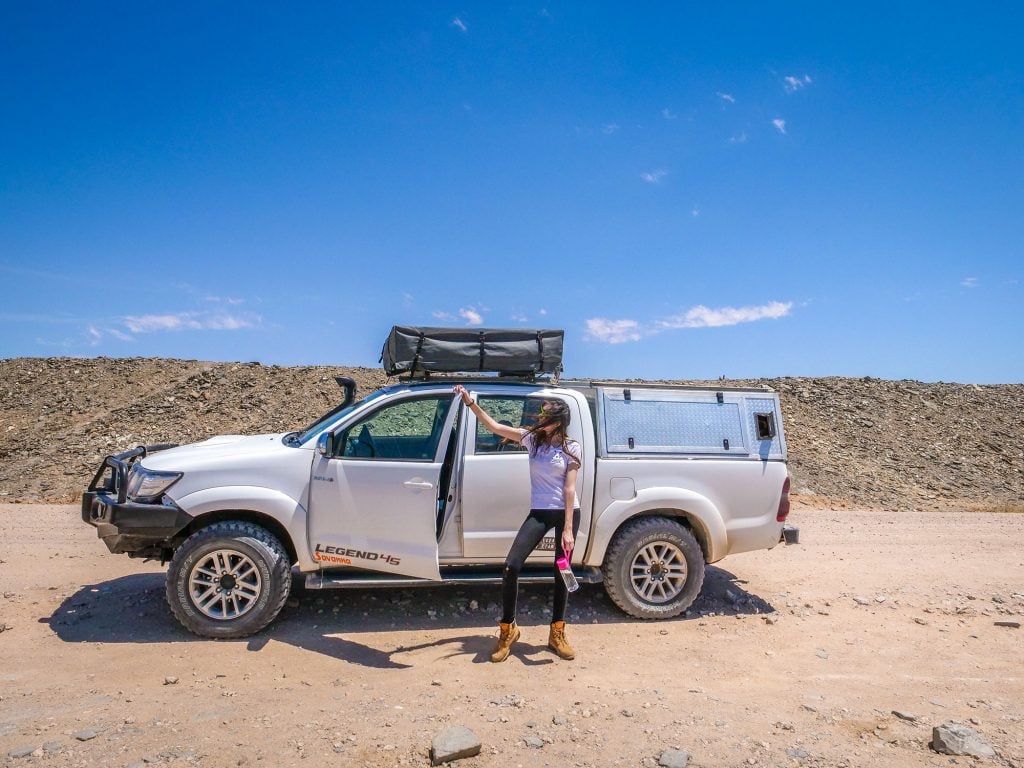
Spotting animals is when a local guide can make a huge difference. Guides can help you find animals that you never would have seen otherwise. They also have a network of other guides who can alert them as to where certain animals are, which greatly increases your chances of seeing them.
The second factor to consider is your safari budget. Although driving yourself may seem like a great way to cut costs while on safari, the savings are not as great as you may initially think once you have added everything up.
Generally, the most expensive part of visiting a park is the park fees. As of 2024, the entry fee for the Masai Mara is $118 per person from January to June, and $236 per adult starting from July 1st onwards.
Update: As of June 2024, self-driving (where you drive yourself) is banned in the Masai Mara in Kenya.
To visit the Masai Mara you would need to use a licensed safari company who will provide a professional driver guide.
Meanwhile, Amboseli charges $118 in the high season and $94 in the low season, while Tsavo costs $61 in the high season and $41 in the low season. These costs are per person, per day, and inclusive of tax.
As you can imagine, these costs add up quickly if you plan on visiting a few different parks during your two-week Kenya safari (which I highly recommend)!

The fees are the same regardless of whether you are going on a self-drive safari or you have booked a safari with a tour operator. Most tour operators usually have the park fees bundled with the overall tour price, so make sure to consider this when adding up the costs of a self-drive safari.
In regards to logistics, you’ll need to rent a 4×4. Car rental and gas can end up getting pretty pricey. You’ll also need to know the basics of car maintenance in case you happen to run into any issues while you’re out on safari, alongside being pretty good at navigation so you don’t get lost in the parks.
I personally have done self-drive safaris in southern Africa in some of the smaller, more manageable parks. However, after seeing the size of the parks in Kenya on guided safaris, I’m not sure that I would want to deal with the hassle of a self-drive safari here based on the reasons mentioned above.
If you have your heart set on doing a self-driving safari, awesome! You can still follow the recommended itinerary below or on my 7-10 Day Kenya Safari Itinerary if you don’t quite fancy a full 2-weeks.
How to Book a DIY Self-Drive Tanzania Safari
- Option 1: Comparison sites which provide multiple quotes from verified suppliers such as Safaris By Ella. Make sure to write you want to self drive in the notes when requesting a quote. (This is a hybrid approach where you’ll drive yourself but they will arrange everything)
- Option 2: Research and book all elements of the trip yourself using Google and online travel agents.
Join the rapidly growing tribe of over 1,000 travellers who’ve booked their dream safari using my insider tips and recommendations. Get your free quotes and my top tips and recommendations now.
Option 2: Local Tour Operator
After trying self-drive safaris and booking through both local and international agents, I personally believe that booking through a local tour operator is a no-brainer!
Local tour operators are the boots on the ground. The best ones know every nook and cranny of the destinations that they work in and can tend to even the smallest of details, and you’ll spot way more animals with a local guide than you would on your own!
They’re also not much more expensive than doing a DIY self-drive safari. Costs are pretty much the same with the exception of your driver guide.
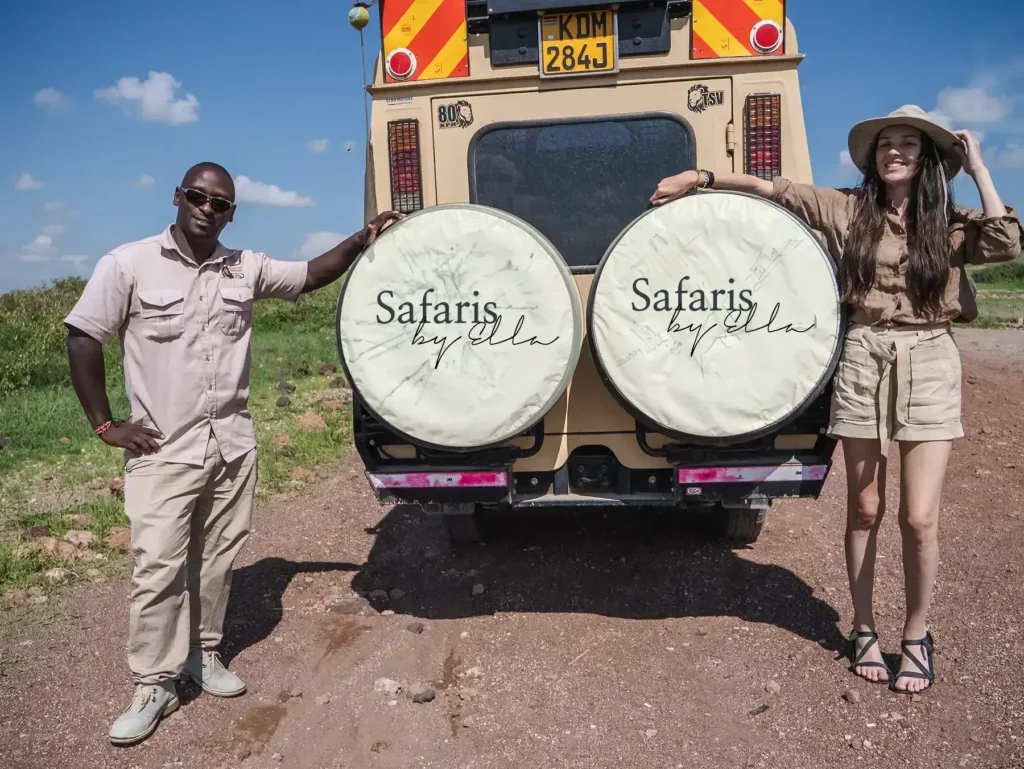
However, your safari experience can differ greatly based on the local tour operator that you end up going with, so this is where you really need to do your research and choose wisely.
I recommend reading as many guest reviews as possible on Google and Tripadvisor to see what other people have experienced. This is one of the best ways to decide whether or not you want to book with a specific provider.
Alternatively, you can use an experienced trip planner such as myself to help you wade through the different tour options and find the best one for you!
I have done safaris with many different providers throughout Africa and had massively different experiences. I am happy to pass on this wisdom to you so that you have the best safari experience possible. You can find out more info about this service at Safaris By Ella.
How to Book with the Best Local Safari Companies
- Comparison sites which provide multiple quotes from verified suppliers such as Safaris By Ella
Join the rapidly growing tribe of over 1,000 travellers who’ve booked their dream safari using my insider tips and recommendations.
Option 3: International Travel Agents
If you’re not convinced that booking through a local operator is right for you, another option is to book through an international travel agent.
These international agents can help you book your entire safari from start to finish and will handle any issues that arise before, during, and after your trip.
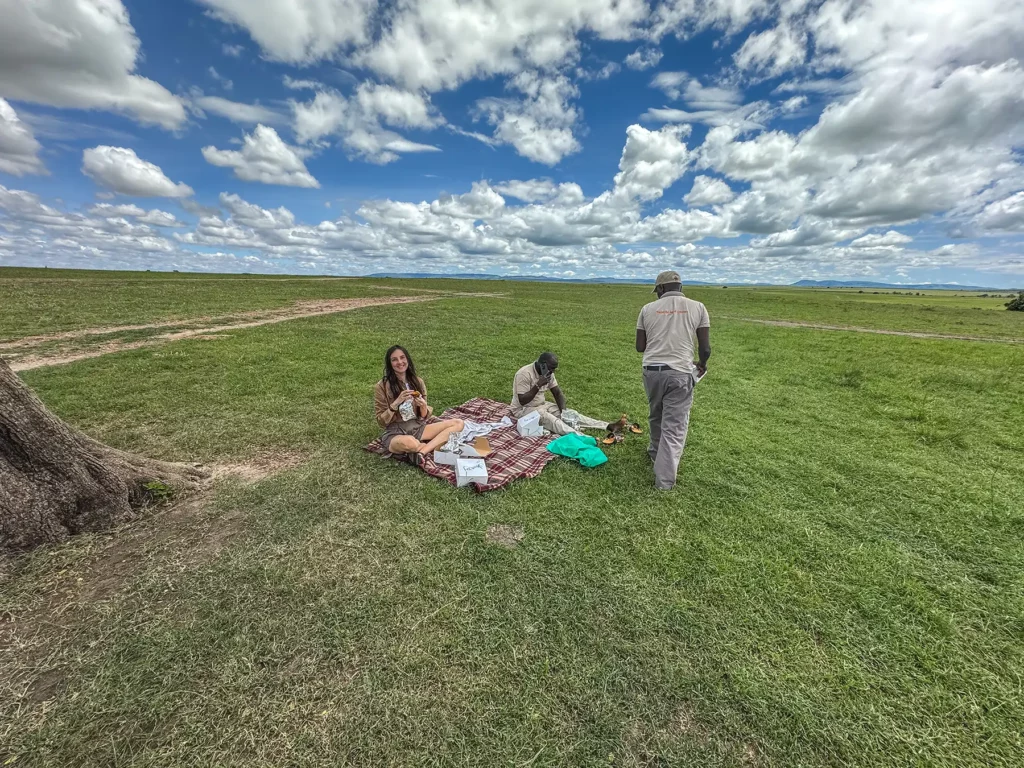
However, all of this extra service may come at a cost. While booking with an international travel agent may seem like the “safest” decision in terms of reliability and customer service, it’s important to know that most international tour operators are simply the middlemen on safari trips.
International agents usually work with local tour operators, mark up the price, and then sell it to you. The end experience is usually the same and the only major difference is the amount of money that you pay for your safari. So bear that in mind if you’re budget-conscious!
A benefit of international tour operators is that they are usually ‘bonded’ which in theory provides payment protection should they go bust before your trip.
Regarding payment protection when I book with trusted local companies, I sometimes pay the deposit via credit card which gives me purchase protection and I typically pay the balance closer to the trip. I’ve always had a good experience booking with local providers but I do choose them very carefully.
How to Book Your Safari with an International Travel Agent / Safari Company
- Comparison sites which provide multiple quotes from verified suppliers such as Safaris By Ella. When you select a luxury budget on the quote request, you will receive a quote from my recommended International safari company as well as my recommended local companies for comparison.
Join the rapidly growing tribe of over 1,000 travellers who’ve booked their dream safari using my insider tips and recommendations.
Option 4: Fly-In Hotel Safaris
If you have a substantial budget and limited time, another option is fly-in safaris.
These high-end safaris transport guests around a region or country using light aircraft. This allows you to see a relatively large area even if you only have a short vacation period.
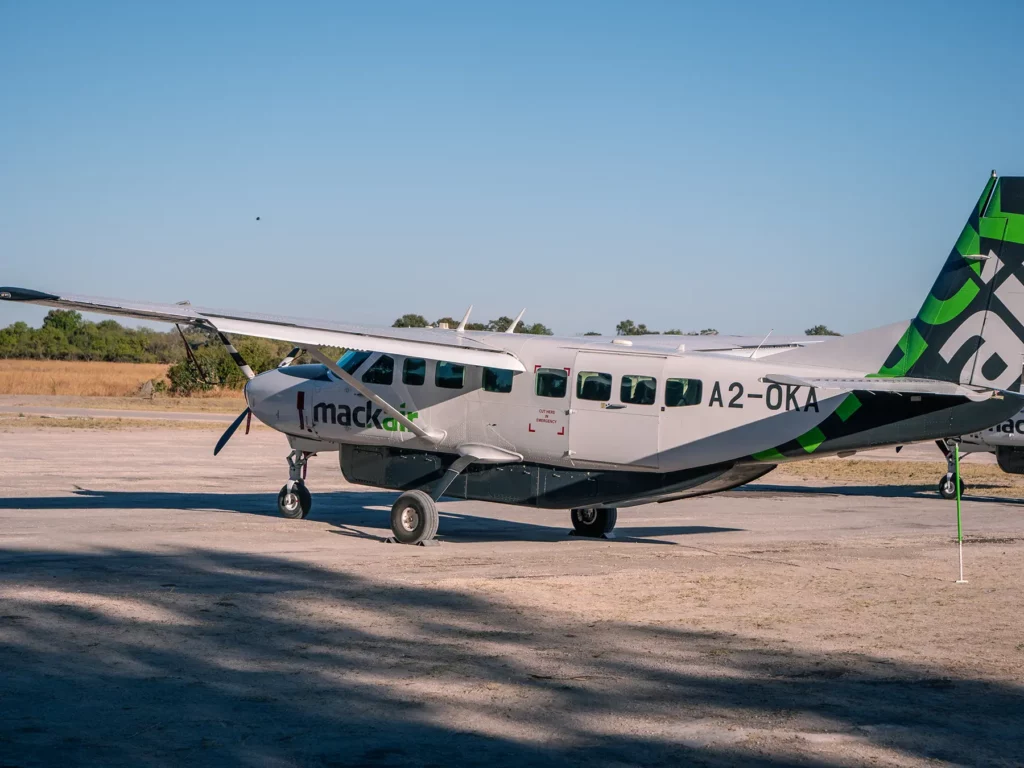
You’ll also get to spend more time in each reserve as you won’t need to drive from park to park. After you fly to your destination, you’ll explore the parks in 4X4s and have a similar experience as those on a regular driving safari. Do note however that hotel game drives aren’t typically private so you will be sharing your vehicle with other guests and competing for the best views.
Fly-in safaris are a good option for people who want to squeeze in as much as possible during their vacation. However, they are understandably some of the most expensive tours out there; all those short flights really jack up the price of the safari package!
How to Book a Hotel-Provided Safari
- Option 1: My recommended tour operators on Safaris By Ella can arrange hotels and air or road transport to and from the hotels. If you opt for the more cost-effective road transport, since they have driven you to the hotel, you might find it cheaper to use the safari company for safaris rather than using the hotel-provided safaris.
- Option 2: Check with your chosen accommodation whether they provide this service and the booking requirements.

So, what is the best way to book a safari?
As you can see, each safari option has its pros and cons. You’ll need to weigh up all the different options and decide which is best for you based on your vacation time and your budget.
After years of travelling through Africa, I recommend using local tour operators. It can save you a ton of money compared to booking through one of the big international travel agents.
Local tour operators can also take care of all the logistics for you from the moment you land to when you depart. This means that you won’t have to worry about booking your own hotels, finding restaurants to eat at, or getting lost in the middle of nowhere!

How Much Does a Kenya Safari Cost?
Although Kenya safari costs can vary wildly depending on your budget, it’s first worth noting that Kenya is no longer considered a ‘budget safari’ destination. As of 1st July 2024, Kenya safari park fees have increased, making the country comparable in cost to Uganda or Tanzania.
As a rough guide, a private Kenyan safari costs from $300 per person per day. This includes hotels, park fees, all meals, transfers and all activities.
Shared group safaris are cheaper, costing around $190 per person per day. Shared safari costs usually include basic camping accommodation. Check reviews carefully, as some shared campsites are poorly maintained with questionable facilities. Generally speaking, the larger your group, the cheaper your safari.
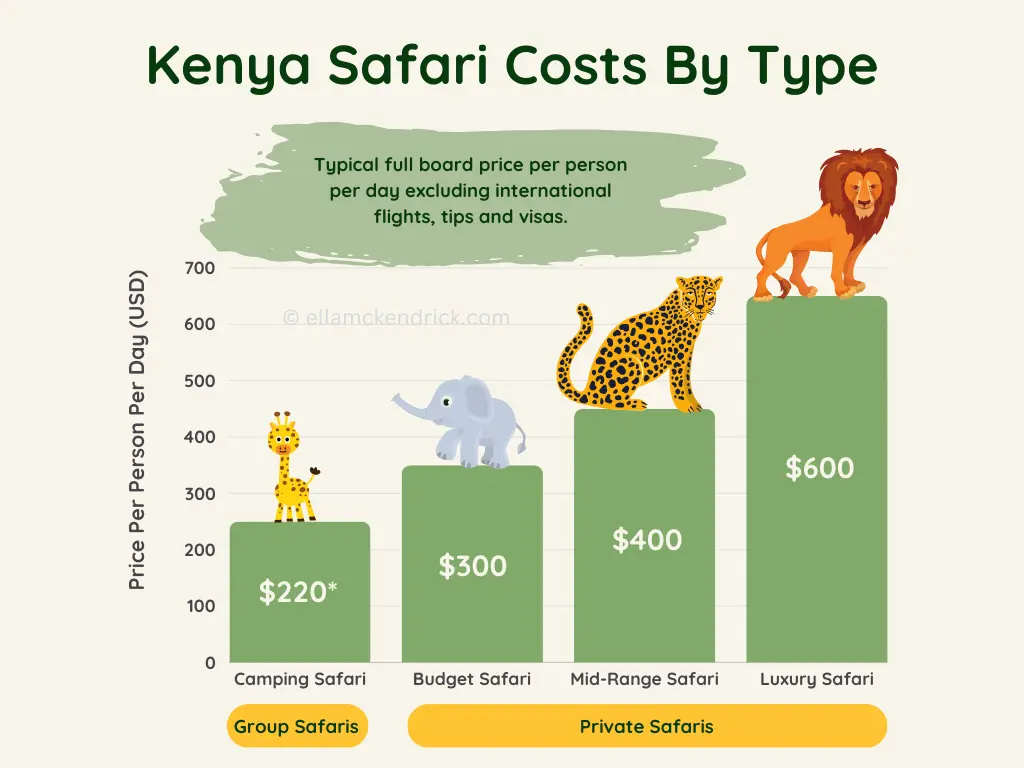
*Whilst you can find group (shared) camping safaris for as little $180 per person the experience is not usually great, due to cost-cutting by the tour company, so I’ve shown $220 as this is the price at which they provide a great experience.
Bear in mind that fees are also impacted by the season you visit. Based on the new safari park pricing, it’s now substantially cheaper to visit between January and June. In fact, a one-day safari in Masai Mara will actually cost half the price at this time of year.
Below you can view a chart of typical safari costs based on your budget (prices are based on a safari for 2 people).
| Comfort Level | Price Per Person Per Day | 7 Days | 10 Days |
| Shared Budget | From $180 PP | From $1260 | From $1,800 PP |
| Private Budget | From $300 PP | From $2100 PP | From $3,000 PP |
| Private Midrange | From $400 PP | From $2,800 PP | From $4,000 PP |
| Private Luxury | From $650 PP | From $4,550 PP | From $6,500 PP |
| Private Luxury + | From $1,000 PP | From $7,000 PP | From $10,000 PP |
Please note that the costs above are for booking through a local operator. Prices will be considerably more expensive if you book through an overseas company or travel agent.
Other costs to factor in include travel vaccinations and malaria tablets, any new clothing you need for the safari, souvenirs, tips, and any additional activities you’d like to do that aren’t included in your safari package.
Below I’ve included a chart which breaks down where the money goes for a safari of 2 people.

Best Time to Go on Safari in Kenya
Generally speaking, the best time to go on safari in any country is during the dry season. This is the time when you’re most likely to see animals as they tend to gather close to watering holes. The foliage is also not as thick so it’s easier to spot the animals when they are hiding.
Therefore the best time to visit Kenya is from the end of December to February and then again from the end of June until September.
Another thing to keep in mind is that the Great Migration usually lasts from around July to October. Going during these months means that you have the chance to see this spectacular display as thousands of animals move together through the landscape. There is simply nothing else like it!
Kenya’s wettest months tend to be April, and May, so you’ll definitely want to avoid these months. Many of the safari lodges and tented camps close during this period, so not only will you have limited chances of spotting wildlife during the day, but you’ll also have limited spots where you can lay your head at night.

How Long to Spend in Kenya
14 days is truly an ideal amount of time to spend in Kenya if you want to make the most of what this beautiful country has to offer.
In 2 weeks, you’ll have enough time to see all of the highlights and a few lesser-known gems, while still having some time for rest after driving long distances between destinations. This also gives you more time for potential wildlife sightings.
But as a minimum, I’d recommend spending at least 7-10 days in Kenya. I have also included itineraries for 3 days or 5 days in Kenya on my blog. You may also wish to combine Kenya with other nearby destinations, such as Tanzania. However, if you wish to visit both Kenya and Tanzania, I’d recommend a 2 week itinerary at the very minimum.
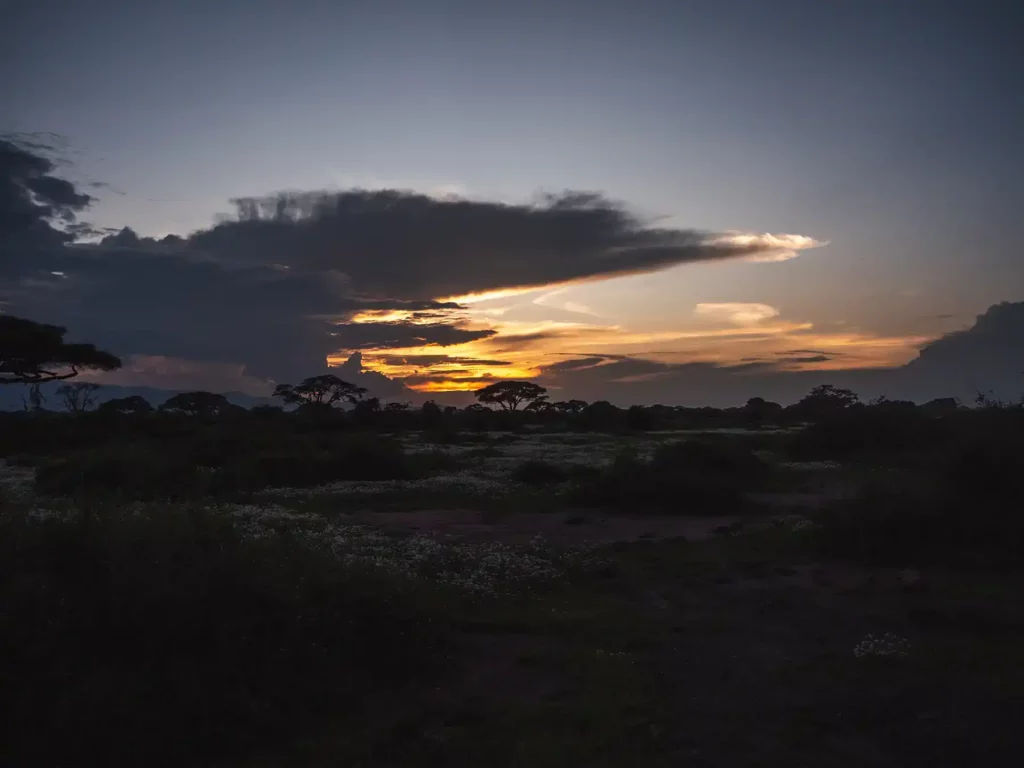
Kenya Safari Logistics
Once you have decided how you are going to organise your Kenya safari, it’s time to figure out what logistics you need to handle on your own – I’ll take you through these below.
If you are booking with a local tour operator, they’ll likely take care of the hotels, transport, and meals, so fortunately there won’t be as much left for you to organise.
Visa
Good news! As of January 2024, you no longer need a visa to travel to Kenya. However, you’ll need to apply for an Electronic Travel Authorisation (eTA) to visit this beautiful country.
You must apply for your eTA at least two weeks before your trip, which can be done online. You can read about the application process and exactly how to apply for your eTA here.

Vaccinations
According to Kenya immigration, all travellers entering from a country where yellow fever is endemic must be vaccinated. This includes neighbouring countries such as Tanzania so if you are planning on doing a multi-country trip, it’s essential that you are vaccinated and that you bring your vaccination certificate with you.
However, even if you aren’t entering from a country that has yellow fever, we highly recommend getting vaccinated regardless as there is a risk of yellow fever in Kenya.
There are also additional vaccinations which are not required to enter the country, but we still highly recommend getting them. You can view a list of recommended vaccinations here.
Medication
Kenya has a risk of malaria, a serious illness that is transmitted by mosquitoes.
There is no vaccination against malaria available so it’s advised that you take anti-malarial medication for the duration of your stay in Kenya. I’d recommend talking to a medical professional about which medication is right for you.

2-Week Kenya Safari Overview
Below, you’ll find the ultimate two-week Kenya safari itinerary. This itinerary includes some of Kenya’s most beloved national parks and reserves where you are basically guaranteed to experience some incredible wildlife sightings.
I designed this itinerary based on my own personal experience, as well as the experience and advice of fellow travellers. I have also done copious amounts of research on the topic to make sure that I am bringing you the best that Kenya has to offer!
Day-by-Day Breakdown of the Ultimate 2-Week Kenya Safari Itinerary
Without further ado, I bring you the ultimate two-week Kenya safari itinerary!
I know that you may want to squeeze in as much as possible during your Kenya safari. However, enduring hours and hours of an “African massage” as you drive over bumpy roads in a 4X4 is not particularly enjoyable for most visitors.
I have also considered the distance and driving time between the parks to provide the most enjoyable itinerary that offers plenty of downtime so that you can relax and unwind throughout your trip.

Day 1: Nairobi
Total drive time (excluding game drives): dependent on what activities you do
Welcome to Nairobi! Your first day in Kenya is the perfect time to get acquainted with your new environment.
Nairobi is not only the capital of Kenya but it’s also the gateway to some of the world’s best nature reserves. Many tour operators are based here and your tour package is likely to include airport pick-up.
Depending on what time your flight arrives (and how tired you will be when you get there!) you can choose to schedule some activities or simply head to the hotel and relax. There is plenty to do in Nairobi but we certainly wouldn’t blame you if you prefer to get a good night’s sleep to prepare for the exciting two weeks that lie ahead!
About Nairobi
Interestingly, the name Nairobi comes from the Maasai phrase ‘Enkare Nairobi’ which translates to ‘place of cool waters’. This is a reminder that this land was originally uninhabited swampland until the British decided to build a railroad supply depot here in 1899.
Today, Nairobi is home to more than four million people. It’s a bustling city full of colourful neighbourhoods, interesting attractions that you’re unlikely to find in any other major city, and a handful of charming colonial buildings.
Nairobi is also home to some of Africa’s most delicious cuisine, unique shopping, and exciting nightlife. Depending on what your interests are, you may want to consider adding a day or two at the end of your safari to spend more time exploring Nairobi!

Where to Spend the Night
If you booked your tour through a local operator, your accommodation in Nairobi will likely be included in the tour package.
If not, you are in luck as Nairobi has an extensive array of accommodations on offer, many of which are very affordable. These range between quiet Airbnbs in the city suburbs, small hotels or guest houses in Nairobi’s downtown, in sprawling resorts.
I personally prefer to stay in Airbnbs. Nairobi can be a bit rough around the edges and I find that an Airbnb in the city suburbs provides the perfect place to chill after a day of exploring.
There are many Airbnb options for studios and one-bedroom apartments or you can rent a room in someone’s house, which gives you the added benefit of being able to see what day-to-day life is like for Nairobi residents.
Many of these Airbnbs tend to be a little outside of the city centre but rideshare services like Uber are readily available and surprisingly inexpensive, which makes getting back to your accommodation very easy. I personally love this one. It has great reviews and is very popular so make sure that you book it well in advance!
Things to Do in Nairobi
As I mentioned earlier, Nairobi is a treasure trove of interesting things to do. Below are some of my favourite places to visit in the city. Again, some of these may be included in your safari package. If not, I highly, highly recommend checking them out!
1. Giraffe Centre
If you’ve ever found yourself scrolling through travel photos from Africa on social media, there is a high chance that you have stumbled across photos of Giraffe Manor. You know the ones….a woman is nonchalantly eating her breakfast while an enormous giraffe pokes its head through the window above her?
For many visitors, the chance to hang out with some of Africa’s favourite long-legged friends is a once-in-a-lifetime opportunity. For many others, the eye-watering price tag means that this is one experience that is going to stay firmly on their bucket list.
However, did you know that you can get up close and personal with these very same giraffes at a fraction of the price?
Located 20 kilometres outside of Nairobi city centre and just across a field from Giraffe Manor, the Giraffe Center is a sanctuary for the rare Rothschild giraffe.
While I am usually a bit sceptical about recommending wildlife sanctuaries, the Giraffe Center stands head and shoulders above the others. The centre has a proven track record of creating a positive impact on Kenya’s population of Rothschild giraffes and has even been able to introduce breeding pairs to some of the biggest parks across Kenya.
This hard work has enabled the number of Rothschild giraffes in Kenya to increase from 120 to over 300 individuals! The centre offers a great way for visitors to learn more about this rare breed of giraffe and it’s a ton of fun too!
When you arrive, you are given a coconut shell full of pellets that you can then feed to the sanctuary’s resident giraffes. The giraffes seemingly can’t get enough of these tasty morsels and you may find yourself covered in giraffe slobber by the end of feeding time – trust me, it’s worth it!
Most people stay at the Giraffe Center for about 1-2 hours. If you want to stay a little longer, there is a nature trail that you can follow on the other side of the road.

2. Nairobi National Park
It’s not often that you can go on a safari surrounded by skyscrapers, but Nairobi is full of surprises!
Although small compared to the other parks in Kenya, Nairobi National Park provides the ultimate juxtaposition between the natural world and the one built by humans. It is the only national park that exists within a capital city.
Easily explored in one day, Nairobi National Park is definitely worth a visit if you have the time to spare. The park is home to the Big Five (elephants, lions, rhinos, leopards, and buffalos), along with cheetahs, giraffes, hyenas, and more. You can go on a game drive or walk along one of the nature trails near the hippo pools.
Although it is possible to self-drive through the park, I suggest booking a tour. These often include pick up and drop off from your accommodation, and the guide will help you spot wildlife that you may miss on your own.
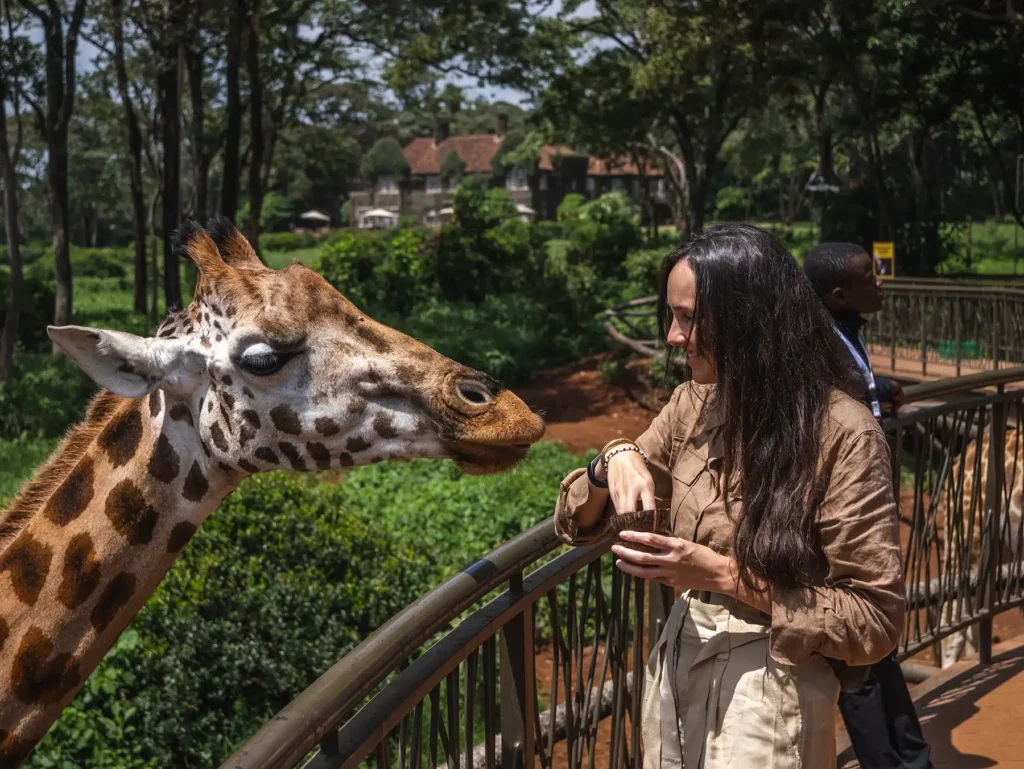
3. Sheldrick Wildlife Trust Elephant Orphanage
Another must-see attraction in Nairobi is the David Sheldrick Trust Elephant Orphanage, which rescues and rehabilitates baby elephants from around Kenya that were the victims of poaching or human-wildlife conflict.
Founded in 1977, the orphanage cares for these oversized goofballs with the goal of releasing the elephants back into the wild. They also fund many of the anti-poaching units found throughout the country.
It’s possible to visit the elephant nursery located within Nairobi National Park. The centre is open to visitors from 11 a.m. to noon every day except for December 25th. It is mandatory to pay the Nairobi National Park entry fees to visit the nursery so this is something to keep in mind when you’re planning your sightseeing activities.
Bookings can be made up to 90 days in advance and you must make them at least one day before you plan on visiting the nursery. You can find all of the details on making a booking on the Sheldrick Wildlife Trust website.
If you want to learn more about the history of the orphanage and the people behind it, make sure to read Daphne Shedrick’s book ‘Love, Life, and Elephants’. The book gives a great inside look into the lives of Daphne and her late husband, as well as heart-warming stories of raising her children surrounded by a menagerie of African wildlife.
4. Eat at One of Nairobi’s Delicious Restaurants
Unless you’ve travelled extensively throughout Africa, you might feel overwhelmed by all the food options here. Nairobi truly is a world-class city when it comes to culinary delights! From Swahili cuisine to international fare, there is something for everyone here.
Some of the most popular eateries in central Nairobi include Kilimanjaro Jamia, a halal restaurant serving up enormous portions, and Thorn Tree Restaurant, an open-air cafe located within Sarova Stanley, Nairobi’s oldest hotel.
My favourite restaurant is the Talisman Restaurant in Karen. They serve Asian-inspired cuisine such as delectable sushi, alongside international favourites. Arrive hungry because they also have an extensive dessert menu!
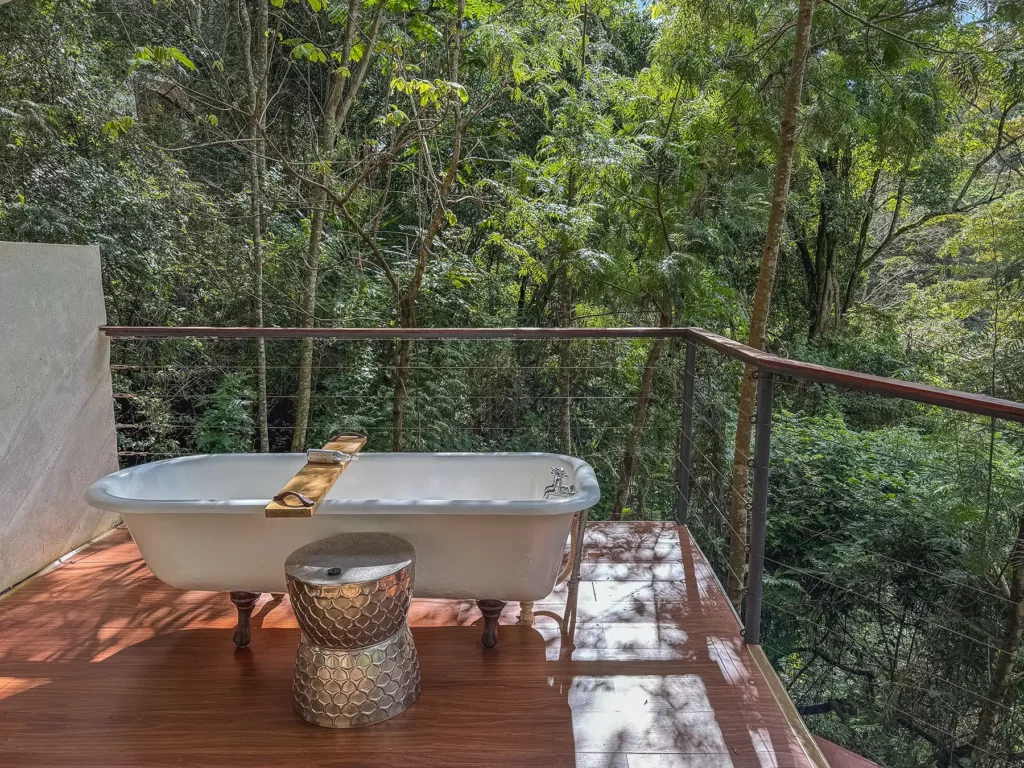
Tips for Visiting Nairobi
After travelling extensively throughout Africa, Nairobi is one of my favourite cities. Although it sometimes gets a bad rap, I have found the city to feel relatively safe, especially compared to some other big cities in Africa.
In my experience, the people here are very friendly and helpful, so don’t be afraid to ask for directions. I usually ask women or families for help when I need it, which has led to some wonderful and memorable interactions with Kenyans.
A good rule of thumb is to just follow the same ‘common sense’ safety precautions that you would in any other big city; keep your valuables at the hotel, take Ubers at night, and avoid sketchy neighbourhoods.
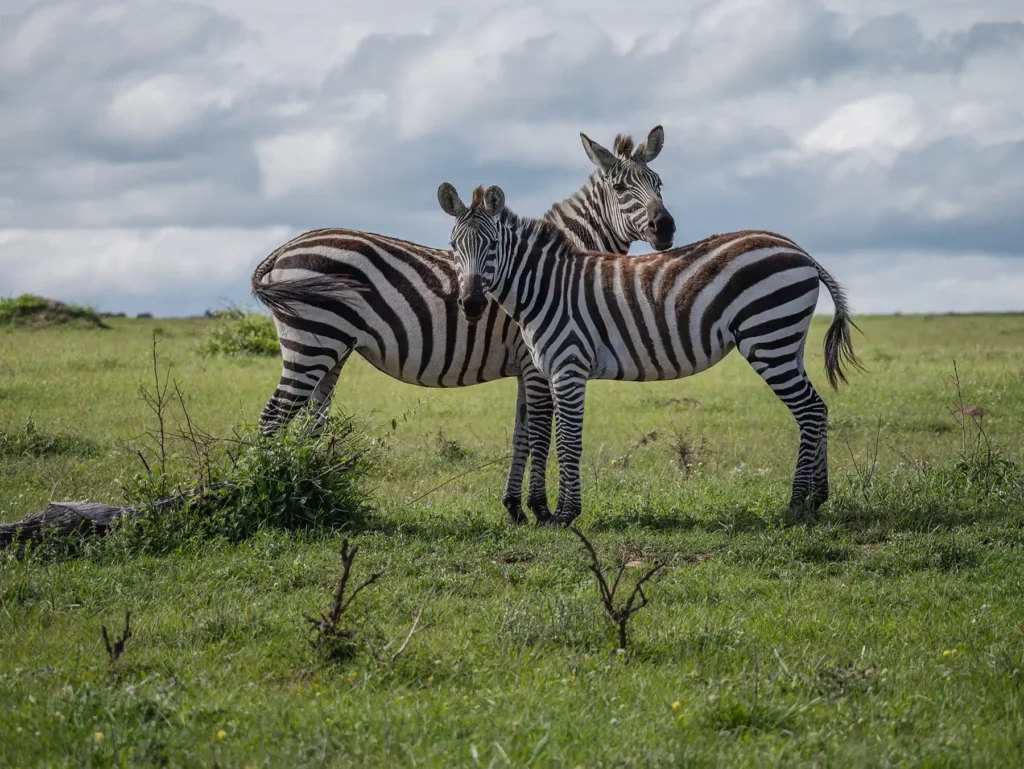
My Experience Visiting Nairobi
Nairobi is one of those cities that is impossible to imagine without visiting! While it might have a ‘rough around the edges’ reputation, I loved Kenya’s energetic capital city.
While I always travel with caution, I found that I always felt safe here, largely because of how friendly and personable the people were. If safety is a worry for you, I recommend staying in the Karen district. You’ll have a ton of restaurants and modern shops on your doorstep.
A couple of downsides to Nairobi is that the city is not pedestrian-friendly! Like most major cities, traffic is an issue, but I also got hassled quite a bit when I tried to walk anywhere.
This was easily fixed by taking Uber rides everywhere, even short distances. Uber is really convenient to use and reasonably priced here.
That said, I would recommend organising a private transfer for longer journeys (such as to and from the airport), especially if travelling at night. The Uber driver who took me to the airport drove way too fast and it was really uncomfortable! Your hotel or Airbnb should be able to recommend good, safe taxi drivers!
Overall, I think Nairobi is a brilliant city. I loved the people, and the excellent food (whether eating in at restaurants or getting Uber Eats when you don’t feel like going out at night), and found it to be a good base for getting my bearings at the beginning of my trip.

Day 2: Nairobi to Masai Mara
Total drive time (excluding game drives): 6 hours
After spending your first day in Nairobi, I hope that you are ready to hit the ground running! The Maasai Mara is Kenya’s most famous nature reserve and is one of the best places to spot Africa’s big cats.
Itinerary
After departing Nairobi, you’ll start making your way west towards the Masai Mara, arguably one of Kenya’s most famous national parks.
During the drive, you’ll catch breathtaking views of the Rift Valley. About 1.5-2 hours in, you can stop at the Great Rift Valley Viewpoint – the perfect spot to stretch your legs and snap some pics.
This is the largest valley in the world and it is constantly changing thanks to the ongoing tectonic shifts that continue to impact its landscape.
You’ll likely take a second quick stop at Narok to refuel. Narok is the closest large town to the Masai Mara and is located about 3.5 hours away from Nairobi. This means that it’s one of the last places to stock up on snacks, gas, or other provisions that you think you may need in the park.
If you’re hungry once arriving in Masai Mara, you can grab a delicious and filling meal at a park lodge, before finishing your day with an afternoon visit to the Maasai tribe.
It takes about six hours to drive from Nairobi to the Talek Gate, the gateway of the Masai Mara reserve, so I highly recommend getting an early start. This saves you from having to drive in the dark and allows you to have plenty of time to spend with the fascinating Maasai!

About The Maasai Tribe
As the name suggests, the Maasai were originally from the areas surrounding Masai Mara Game Park. They are one of the most famous tribes in Africa.
This nomadic tribe can be found throughout Kenya and northern Tanzania and is well-known for its distinctive culture and rituals. Fortunately, they have managed to protect their ancient customs for centuries, allowing visitors to observe them today.
While you are with the Maasai, take a close look at their iconic red chequered shukas (blankets) and their colourful beaded jewellery. The elaborate designs and colours represent the different stages of life and the jewellery is generally worn for special occasions such as weddings.
If you’re hoping to find a great souvenir to take home as a reminder of this special time in your life, these shukas are one of the best!

Where to Spend the Night
The Talek Gate is conveniently located close to many of Masai Mara’s safari lodges and tented camps, making it one of the best places to stay as it’s just a short drive to the gate each day.
As you can imagine, the closer you are to the gate, the pricier the accommodation gets. But keep in mind that the less time you spend driving to the park, the more time you get to spend searching for animals!
Another great area to stay in is near Ololaimutiek Village. This is located about 1.5 hours South of Talek. While the drive time from Nairobi is about the same to get to Ololaimutiek Village as it is to Talek, the village is further away from the gate.
If you really want to splurge, there are also a few lodges located within the park itself. They certainly get you close to all the action but these tend to be very expensive. On top of that, you also have to pay higher park fees for staying inside the gates.

Tips for Visiting The Maasai Tribe
The Maasai have become a living symbol of Kenya, so it’s understandable that many visitors jump at the chance to visit a Maasai tribe.
However, although most tours promote understanding and appreciation of Maasai culture, all visitors must treat the Maasai with dignity and respect.
Always remember that you are entering their home. They are happy to share their culture with you but you must follow a few do’s and don’ts to ensure everyone can enjoy the experience. Never take photos of people without their permission and refrain from giving candy or sweets to local children.
It’s also a good idea to go into the experience with an open mind and be willing to put yourself out of your comfort zone. You may end up trying something completely new where you feel completely awkward, but isn’t that all part of the fun?
These days some Maasai Tribe visits can feel a bit commercialised so ideally ask your safari company to arrange a visit to a lesser-visited boma for a more authentic visit.
At the end of most visits you’ll be shown jewellery made by the tribe which you can buy – don’t feel any pressure to buy and feel free to offer a lower price you feel comfortable with. I do usually buy a thing or too as the Maasai earning money from tourism encourages them to help protect the wildlife which brings in tourists.
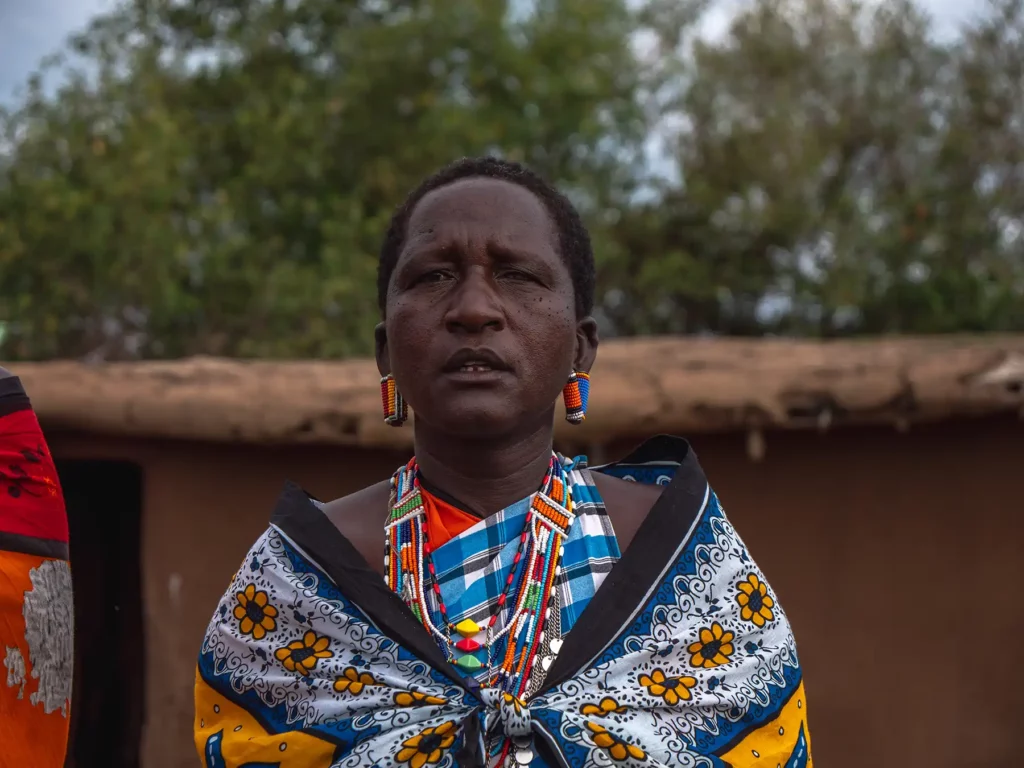
My Experience Visiting The Maasai Tribe
Visiting a Maasai Boma on the edge of the Masai Mara was an unforgettable part of my Kenya safari trip. The tribe I visited was only a short drive from the Little Zebra River Camp where I was staying, which was a bonus.
The tribe was exceptionally friendly and really hospitable. They even invited us to spend the night with them, and I would have definitely taken them up on the offer if my itinerary wasn’t already so packed!
I loved seeing the welcome dance performance, including the Maasai warrior jumping dance. The strongest warrior is the man who can jump the highest, and traditionally the winner will win a wife!
Eric, our Maasai guide, was one of the chief’s many sons. He showed us around their boma, which is a circle of houses around a grassy area full of cows.
We also saw inside one of the traditional houses, which are constructed by the women out of cow pat with a grass roof. Inside the house was very dark as there were no windows, except for one used as an extractor near the kitchen section.
At the end of your tour, you’ll usually be taken to a market area, which is a good place to pick up a souvenir. Prices are intended to be haggled, so a bracelet that’s $20 will usually be sold to you at closer to $5.
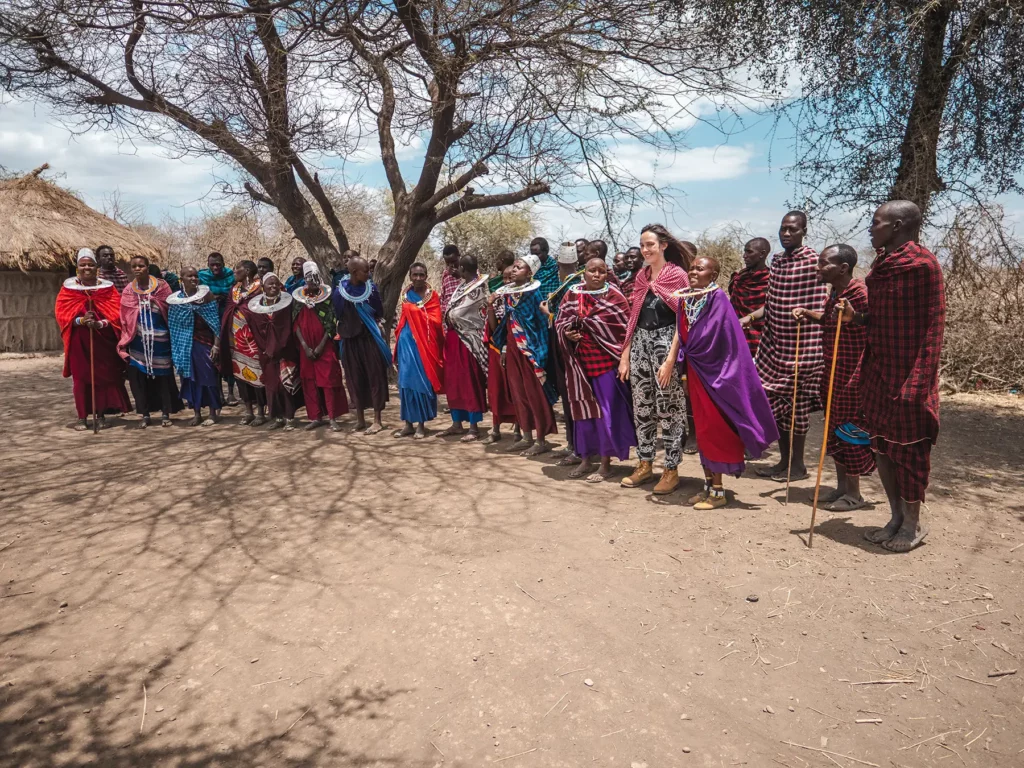
Day 3 – 4: Masai Mara National Reserve
Total drive time (excluding game drives): 0 hours
Over the next two days, you will experience the many sides of the Masai Mara and I am sure that by the end of your stay, you will understand why it is Kenya’s most famous attraction. Be prepared for some early mornings (and early evenings!).
Itinerary
The best time to go on safari is the early morning when the animals are most active, so make sure that you’re up and at ‘em when the sun comes up! The reserve gates open at 6 a.m. so I recommend setting your alarm for around 5 a.m. depending on how far your lodge is from the gate.
If you can, try to stay in the park until the gates close again at 6 p.m. This helps optimise the amount of time spent in the park, thus increasing your chances of some unforgettable sightings.
Although this means spending long hours in a safari jeep, I promise it’s worth it! I once saw a lion take down a wildebeest right before sunset. It was incredible to see something so powerful and I am very glad we stayed in the park that day!
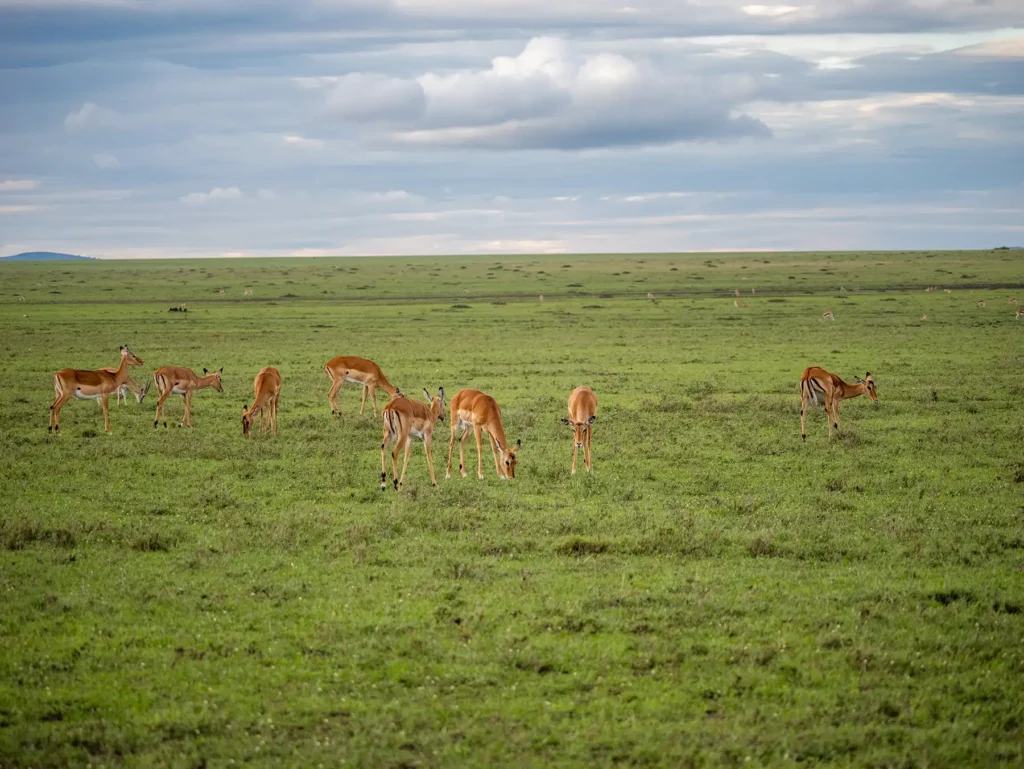
The Masai Mara charges entry fees every time you enter the park, so if you went back to your lodge for lunch, you’d need to pay the entry fee again when you return. Instead, grab a packed breakfast and lunch from your lodge before you leave, so you can spend the entire day in the park.
Almost every safari goer requires packed lunches, so your lodge should have no trouble preparing this. Just make sure to let them know if you have any dietary preferences (i.e. vegetarian, vegan, etc) the night before.
Although it may be pricey if you have to pay for the packed lunch separately, there is generally quite a lot of food provided. Trust me, don’t skimp out on this one as you’ll regret it later when you can’t hear a lion roaring over your stomach grumbling!
You’ll finish off the day with another great meal from your lodge. It truly is amazing the variety of food that can be whipped up in the middle of the Masai Mara!
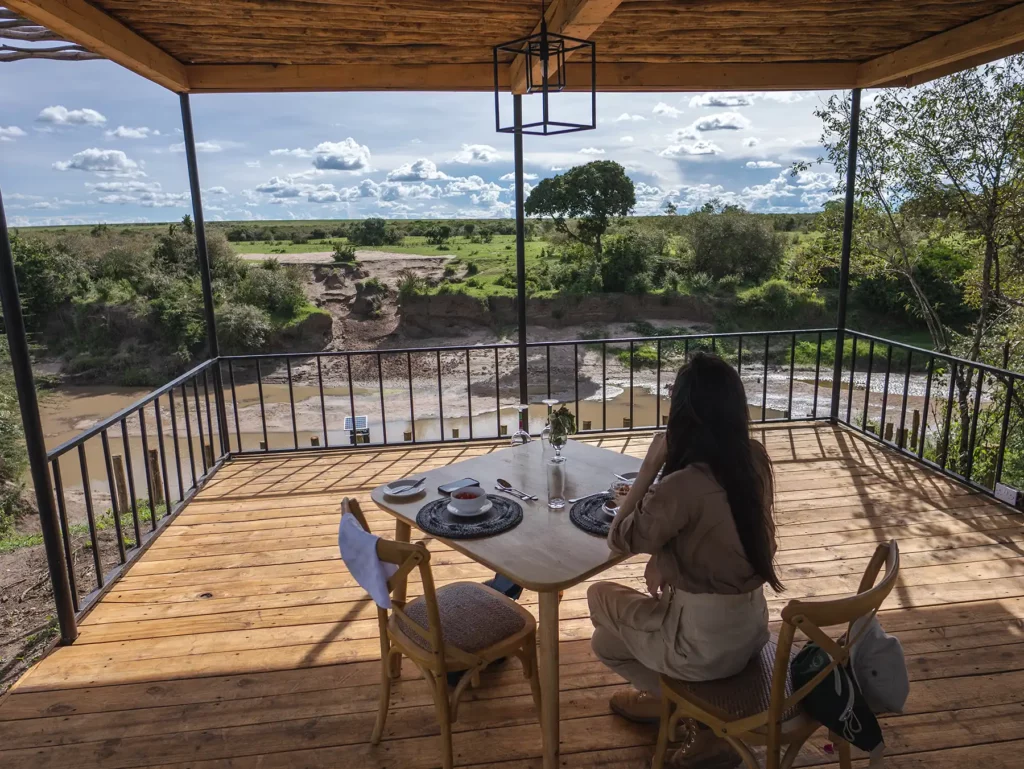
About The Masai Mara
The Masai Mara truly does live up to its reputation. Part of the Serengeti ecosystem, this massive expanse of grasslands boasts an incredible array of wildlife including the Big Five, lions, leopards, cheetahs, hyenas, and more.
Since there are sizable populations of many of these animals living here, the Masai Mara is considered one of the best places for animal spotting in the world.
From mid-July to mid-September, the reserve is also the stomping grounds (literally) for millions of wildebeest as they cross over from the nearby Serengeti National Park.
As the adorably awkward wildebeests search for fresh grazing, they have to cross the Mara River where dozens of hungry crocodiles are waiting for their next meal. It’s certainly a harrowing journey but an incredible one to witness.

Tips for Visiting The Masai Mara
A safari through the Masai Mara is a spellbinding experience. If this is your first safari, you may be overwhelmed at seeing so many breathtaking animals all around you. Meanwhile, if you have done safaris before, you may be floored by the sheer volume of wildlife on display.
While the experience is very special, there are a few things that you can do to make it even better!
The first tip is to wear layers of clothing. The grasslands can be very chilly in the morning but become scorching hot in the late morning and afternoon. Wearing a lot of layers that you can take off throughout the day gives you the chance to add or take away clothes as the temperature changes.
Don’t forget to bring a sweatshirt or jacket as well. It may not feel very cold when you first leave the lodge but the morning air can start to feel quite cold when you are zooming around in a vehicle.
You should also wear light neutral-coloured clothing. Not only does this help reflect the sun but it’s also a good way to deter tsetse flies. These annoying little insects are attracted to dark-coloured clothing and can leave you with some pretty nasty bites.
I also recommend staying covered and slathering on some insect repellent before you head out for any afternoon or evening trips in Kenya.
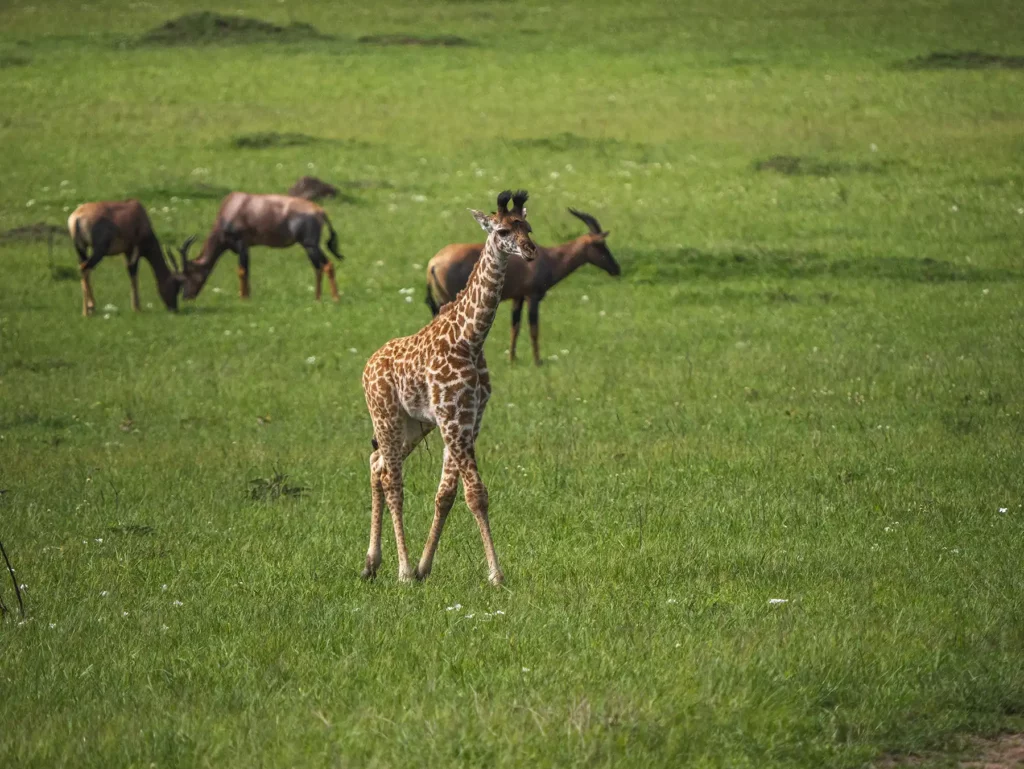
My Experience Visiting The Masai Mara
Just to warn you, I’m very biassed, as the Masai Mara is my absolute favourite safari destination in Kenya!
I just had so many incredible wildlife sightings here, from seeing a mother cheetah tussling with her four cubs to a leopard in a tree with her gazelle kill. Both felt magical to witness up close.
One of my favourite lion sightings (I’ve had so many great lion sightings here!) was of a massive male lion beside a buffalo kill. Again, I couldn’t believe how close we were to this huge predator, as he guarded his kill to ensure it would be safe from scavengers as his pride slept in the bushes nearby.
My drives here were dawn-till-dusk, so we always took packed breakfasts and lunches with us. It was worth it as we got to see so much wildlife, including tons of baby animals. My most recent trip took place during November which brought short rains and the arrival of lots of new-born herbivores. We saw baby gazelles, topis, giraffes, and zebras!
I also saw a few elephants, including a breeding herd with cute young calves, crocodiles, many hippos, and a whole clan of hyenas. I even saw a black rhino, which is rare here!
I stayed at two different camps here – Enkorok Mara Camp near Ololaimutiek Village, and the Little Zebra Rivers Camp in Talek. The latter was my favourite, as it felt more central and was close to two separate gates into the park.
You can watch a video of my experience visiting the Masai Mara below.
Day 5: Lake Naivasha
Total drive time (excluding game drives): 5 hours
Once you have had your fill of the Masai Mara, it’s time to head northeast towards Lake Naivasha, one of the best places for bird-watching and hippo-spotting in Africa.
Itinerary
Today’s journey will take between 5-6 hours, taking you across a variety of roads ranging from smooth as butter to full-blown African massage. An early start ensures that you’ll arrive at your next destination in time for lunch and afternoon activities and avoid driving at night time.
Once you arrive at Lake Naivasha, grab lunch at your lodge and take a short rest before heading out for the rest of the day’s activities.
One of the most popular things to do here is take an afternoon boat ride, which provides a new perspective on the lake’s wildlife. Most boat trips include a stop at Crescent Island where you can go on a walking safari and see a wide variety of animals including zebras, wildebeest, gazelles, and giraffes.
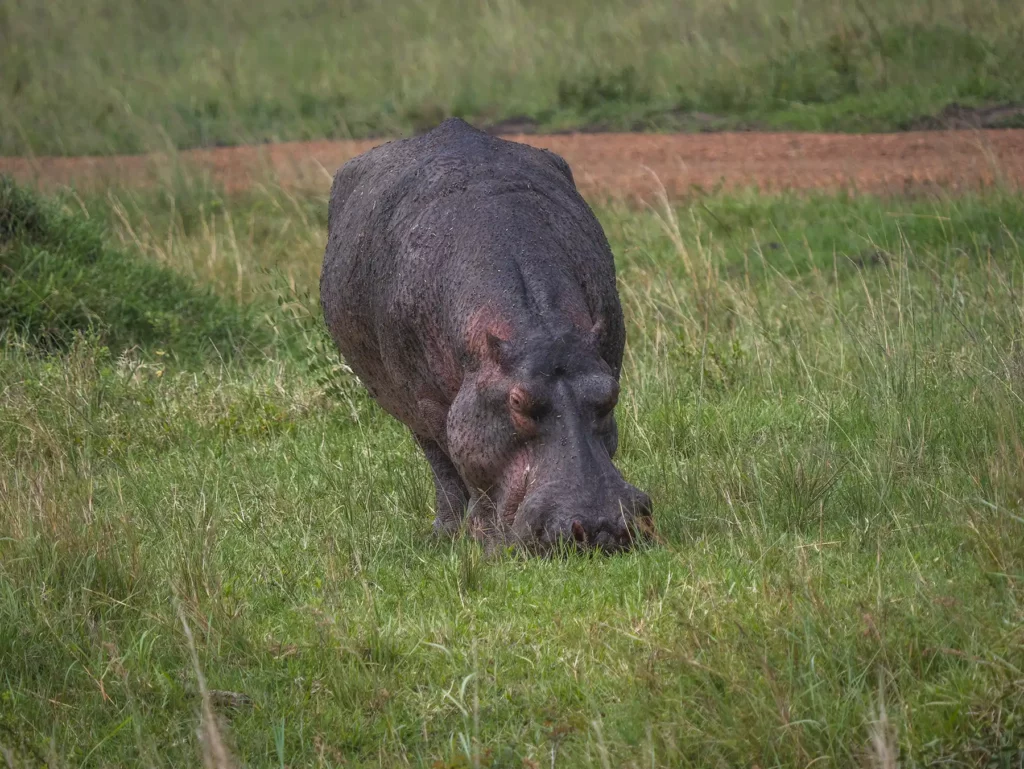
About Lake Naivasha
Situated in the Great Rift Valley in Nakuru County, Lake Naivasha is the valley’s highest lake, perched nearly 2,000 metres above sea level. The name ‘Naivasha’ comes from the Maasai word for ‘rough water,’ owed to the frequent storms that impact the area.
Home to strong populations of hippos and flamingos, as well as over 400 different types of bird species, this freshwater lake provides ample opportunities for bird-watching from either the papyrus-covered shoreline or during a relaxing boat ride.
You can visit Crescent Island in Lake Naivasha via short boat trip. It’s a privately managed game sanctuary renowned for its walking safaris among free-roaming wildlife in a scenic lakeside setting.
With no lions or elephants, it’s one of the few places in Kenya where visitors, including families, can safely explore on foot while animals remain calm and approachable. The island also has a touch of cinematic history, films like Out of Africa and Living Free were shot here, and some of the animals introduced for filming still roam the island today.
Where to Spend the Night
There are a few places to stay on the banks of Lake Naivasha, as well as a few cottages on Crescent Island. Try to book a hotel right on the lake so that you can admire the view and possibly see some birds gliding by in your downtime.
Tips for Visiting Lake Naivasha
If you are going on a boat trip, which I’d recommend, do this in the afternoon so you can go for sun downers on Crescent Island.
When you go on the boat trip, this often includes a walking safari in Crescent Island so wear closed toe shoes ideally with ankle support as it will be more comfortable for walking through the vegetation on the island and bring a full water bottle per person as the walk can take an hour or so.
There are wild animals on Crescent Island and they are very used to people, even so, don’t be too noisy and give them space.
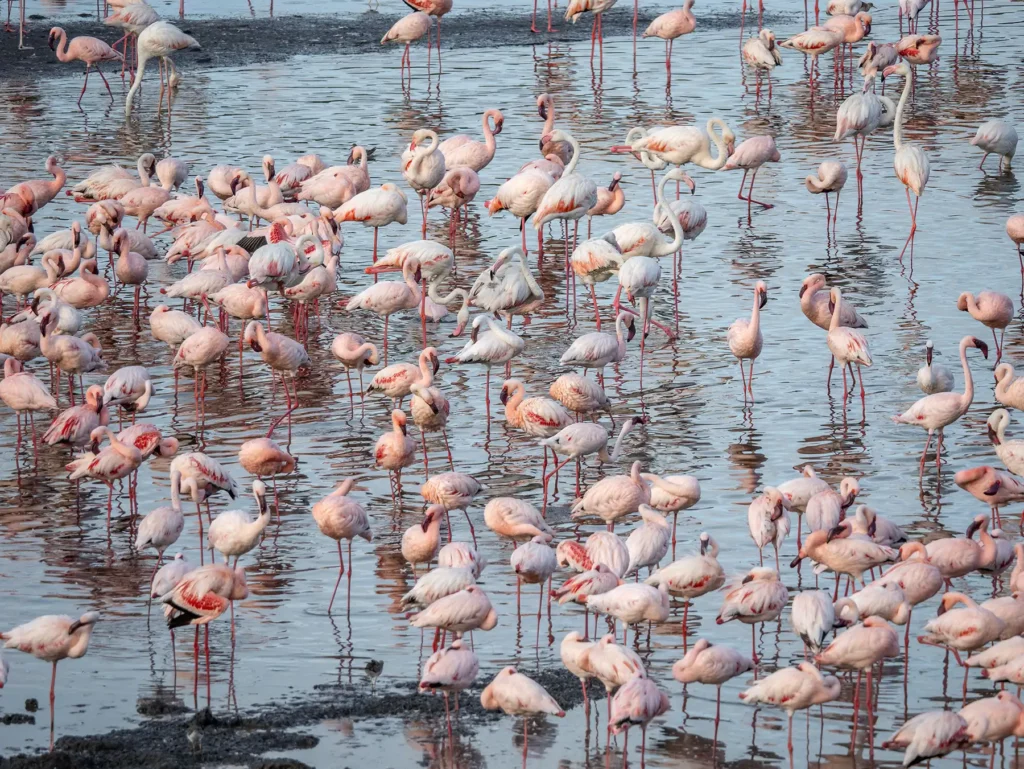
Day 6: Lake Nakuru National Park
Total drive time (excluding game drives): 2 hours
Today, we are exchanging Lake Naivasha with Lake Nakuru, one of Kenya’s most ecologically diverse destinations.
Although these lakes are only a few hours apart, they offer very different experiences. If you need to get some exercise after spending so much time in the car, this is the place to do it thanks to the unique activities on offer here.
Itinerary
After another early start, you will make the short, two-hour drive to Lake Nakuru, arriving just in time for a late morning game drive in Lake Nakuru National Park.
After taking your first quick look at the area, it’s time to grab some lunch and decide what activities you want to do in the afternoon! Some of the options include horse riding or a cycling safari in the afternoon. Alternatively, you can do another game drive if you prefer something a little more relaxing.
About Lake Nakuru
Home to more than 450 bird species and 83 mammal species, including the Big Five, Lake Nakuru has the greatest amount of biodiversity of all of Kenya’s Great Lakes.
Created in 1961, the park was made a rhino sanctuary in 1984 and has been considered one of the best-conserved places in the country for decades.
While it is home to some of Kenya’s most magnificent mammals, Lake Nakuru is most famous for its population of flamingos. Although the number of flamingos has decreased over the past decade due to heavy flooding, their numbers are on the rebound.
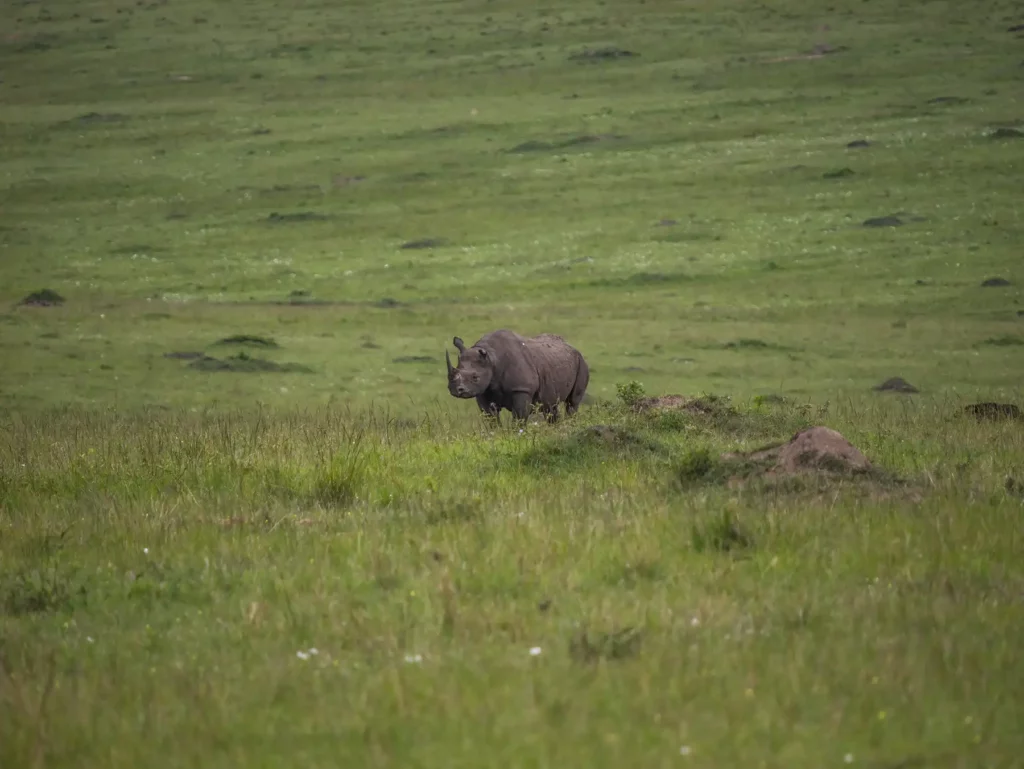
Where to Spend the Night
Lake Nakuru has a wide array of accommodations ranging from cost-effective cottages to luxurious game lodges, and some of the higher-end spots are located within the park itself.
Most of the other accommodation is located just off Highway A104. You can also stay in downtown Nakuru, the biggest city in the Rift Valley.
Most of the accommodation is located just a short drive from one of the park’s three main gates. Note that Baboon Cliffs is located closest to the Main Gate so you may want to keep this in mind when you are choosing your accommodation!
Tips for Visiting Lake Nakuru
If you want to get sweeping views of Lake Nakuru, head to Baboon Cliffs in the early morning, one of the best spots to view the park’s breathtaking vistas.
The cliffs are named after the mischievous baboons that live here but if you go early enough, you should miss them and all the mayhem that they cause!
Lake Nakuru’s location right by the equator means that it doesn’t receive the extreme heat that other parks do, which is a relief to any travellers who struggle with Kenya’s scorching temperatures.

Day 7: Ol Pejeta Conservancy
Total drive time (excluding game drives): 4 hours
Today, you’ll drive about four hours northeast to Ol Pejeta Conservancy.
This interesting conservancy has become a bit of a poster child for conservation success and it provides some unique experiences that you’re unlikely to find anywhere else. It’s also one of the most family-friendly safari destinations in Kenya.
As the icing on the cake, you can often see Mount Kenya looming in the distance from Ol Pejeta, which provides an amazing backdrop for your photos.
Itinerary
After driving from Lake Nakuru to Ol Pejeta, you can spend the rest of the day on a game drive. Make sure to keep your cameras out as you’ll certainly want to get a few photos of the conservancy’s rhino population.
During your time in Ol Pejeta, you can also visit the Equator sign and see the touching Rhino Memorial, which was built in memory of all of the rhinos that have been poached. Alternatively, head out on a horse riding trip or watch the K9 anti-poaching unit during their tracking practice.

About Ol Pejeta Conservancy
Ol Pejeta is currently the largest black rhino sanctuary in East Africa and is home to the world’s last remaining northern white rhinos.
Believe it or not, Ol Pejeta got its start as a working cattle ranch in colonial Kenya before being upcycled into one of Kenya’s best examples of innovative conservation. As a result, livestock and wildlife coexist here, and many migrating animals use the area as a migration corridor as they make their way between neighbouring ranches and conservancies.
It’s also the only place in Kenya where you can see chimpanzees. Although chimps aren’t endemic to Kenya, the conservancy, in conjunction with the Jane Goodall Institute, provided a much-needed home to orphaned chimpanzees after their rescue centre in Burundi was closed in the early 90s due to the civil war.
Where to Spend the Night
Ol Pejeta boasts a whopping nine tented camps, homestays, and lodges. Each accommodation has its own style, so there is something there for every taste and budget, ranging from rustic stables to luxurious river camps.
Tips for Visiting Ol Pejeta Conservancy
Despite being one of the closest safari parks to Nairobi, Ol Pejeta is much less crowded than some of the other parks on this itinerary. This makes the experience even more special.
In saying that, it’s a really good idea to book your accommodation well in advance to ensure that you get something to suit your tastes and budget.
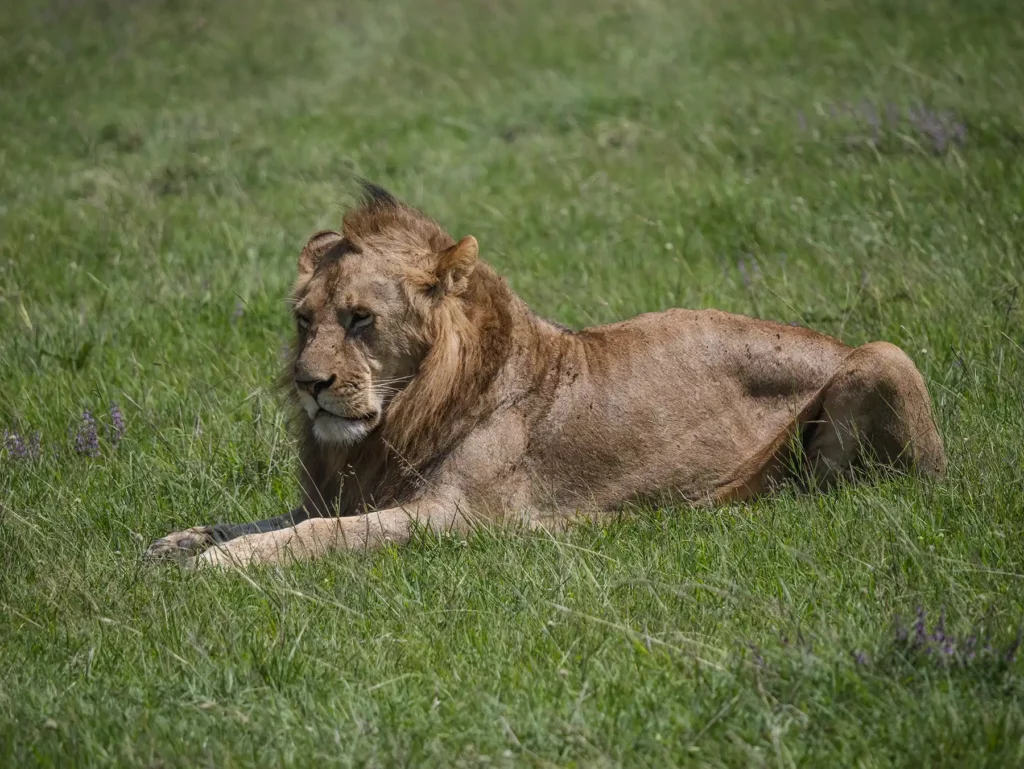
Day 8: Ol Pejeta Conservancy to Amboseli National Park
Total drive time (excluding game drives): 8 hours
Get ready for a huge day of driving, as today you’ll cover over 400 kilometres! Amboseli National Park is located right by the border of Kenya and Tanzania, so you’ll need to get an early start to avoid driving at night.
Itinerary
The drive should take anywhere between 8-10 hours, so you can expect to spend the entire day on the road. You’ll pass through Nairobi during the drive, so I recommend squeezing in a lunch break when you pass through.
Once you arrive in Amboseli, you’ll likely want to grab a quick dinner and head straight to bed!
Where to Spend the Night
There are three safari lodges located inside Amboseli National Park. Generally speaking, staying within any of the national parks allows you to save on driving time between your lodge to the park gates. However, this convenience often comes with a pretty high price tag.
But things are a little different at Amboseli.
Here, there are many different safari lodges to choose from and most are located within spitting distance of Kimana Gate. The gate is close to one of the park’s major elephant crossings so in actuality, you won’t lose too much time if you stay in one of these non-park lodges.
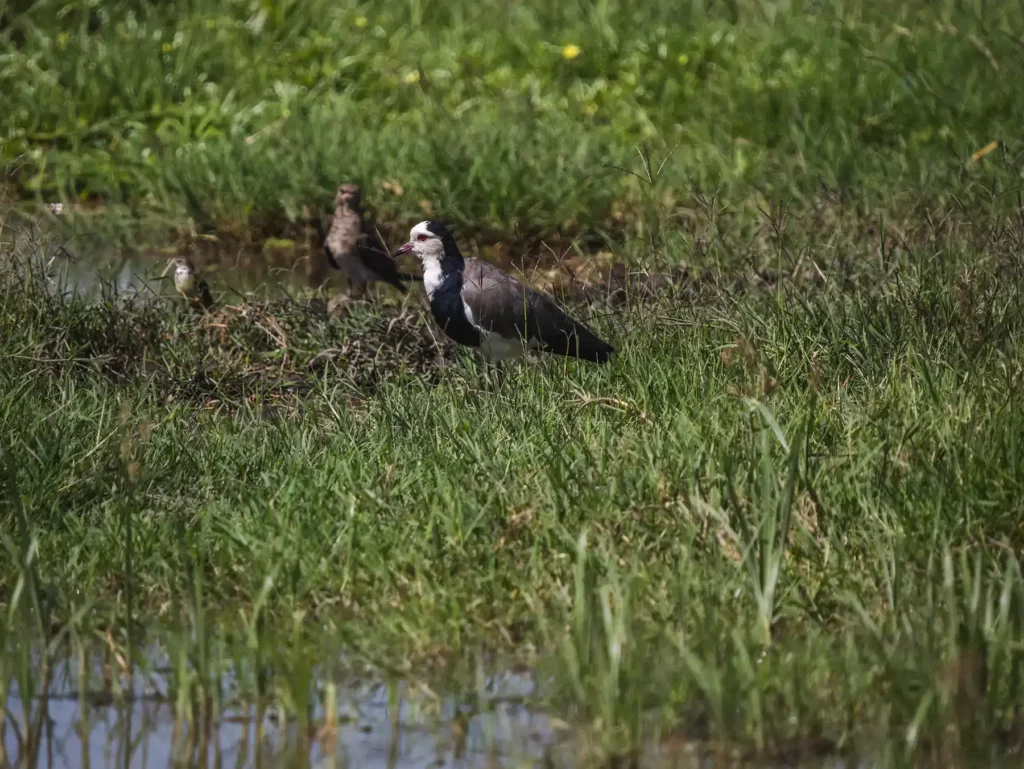
Day 9: Amboseli National Park
Total drive time (excluding game drives): 0 hours
After yesterday’s drive-a-thon, it’s time to enjoy the fruits of your labour with a day of excitement in Amboseli. Famous for its enormous herds of elephants and showstopping views of Mount Kilimanjaro, this UNESCO World Heritage Site is one of Kenya’s premier wildlife parks.
One of the highlights of the park is the ‘big tuskers’, elephants with gargantuan tusks that weigh over 50 kilograms and stretch all the way to the ground. Amboseli and neighbouring Tsavo West National Park provide a home base to some of the last big tuskers in the world.
Amboseli is also home to four of the Big Five and over 600 different bird species.
Itinerary
Get ready for a full-day game drive in Amboseli. The park gates open at 6 a.m. so make sure to wake up early today.
You want to be at the gates right when they open because this will give you plenty of time to get to the elephant crossing into the swamp. The early morning is also the best time to spot big predators such as lions and cheetahs.
In the afternoon, head over to Observation Hill to enjoy your picnic lunch while taking in the sweeping panoramic views over the park. Then it’s back on the road for an afternoon safari.
As in the Masai Mara, try to stay in the park as long as you can as this will greatly increase your chances of spotting more animals.

About Amboseli National Park
Amboseli National Park is significantly smaller than the Maasai Mara but what it lacks in size, it makes up for in wildlife. The park has some of the largest herds of African elephants in the world!
Rumour has it that the reason why the elephant population is so strong here is because the Maasai tribe has scared away any would-be poachers. And elephants aren’t the only thing you may find here in droves. The park also has healthy populations of lions, cheetahs, giraffes, hyenas, and buffalos.
The word Amboseli comes from the Maasai word ‘Empusel’ which means ‘salty dust place’. This description is especially true of Lake Amboseli in the dry season. While this may not sound overly appealing, this landscape makes it easy to spot wildlife.
Amboseli can easily be explored within 24 hours. This is especially the case during the rainy season when Lake Amboseli, which already takes up a good proportion of the park, fills up and limits access to the park’s western side.
Don’t let this deter you though – most of the wildlife sightings that occur in Amboseli are in the eastern section of the park which you have access to year-round.
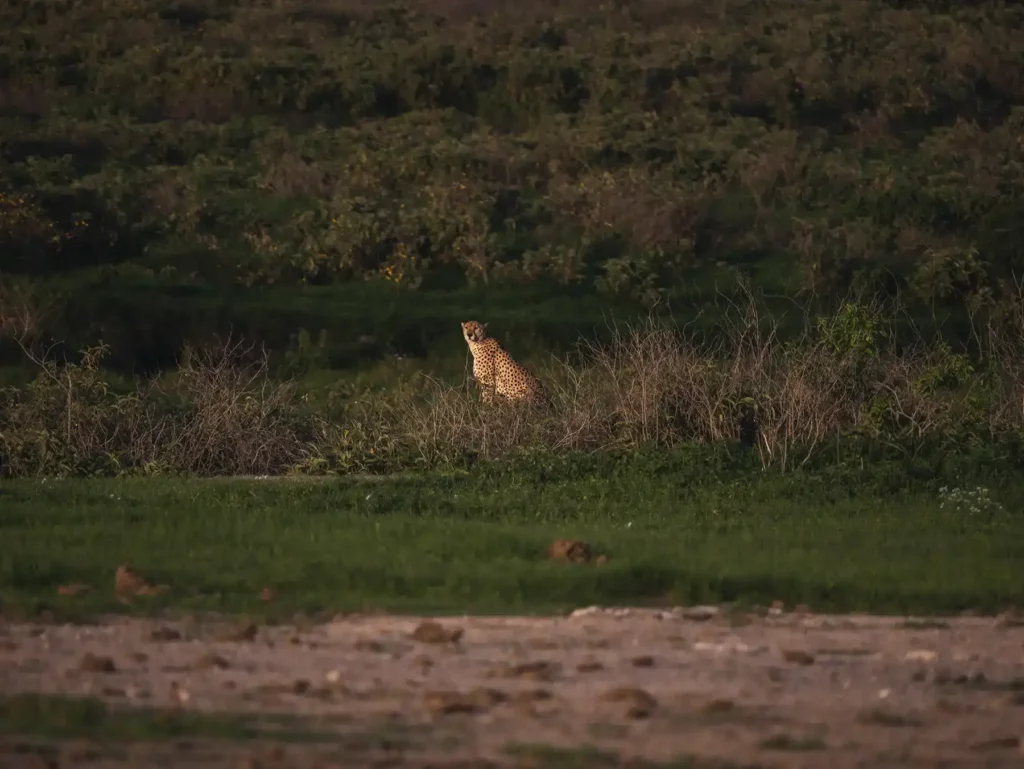
Where to Spend the Night
Tonight, you’ll stay in the same tented camp or safari lodge as the previous night.
Tips for Visiting Amboseli National Park
The best time to see the park’s world-renowned elephant herds is around 7 a.m. or 5 p.m. when the herds make their way to and from the park’s swamps.
The elephants usually lounge around in the swamp during the day which makes it very difficult to spot them, which is why it’s really important to arrive early when the park gates open.
It’s important to know that Amboseli also tends to be one of the hottest national parks in Kenya. It’s wise to wear loose, breathable clothing that protects your skin from the blazing sun.
As the finishing touch, be generous with the sunscreen and throw on a hat. You should also drink plenty of water while on safari to avoid dehydration.
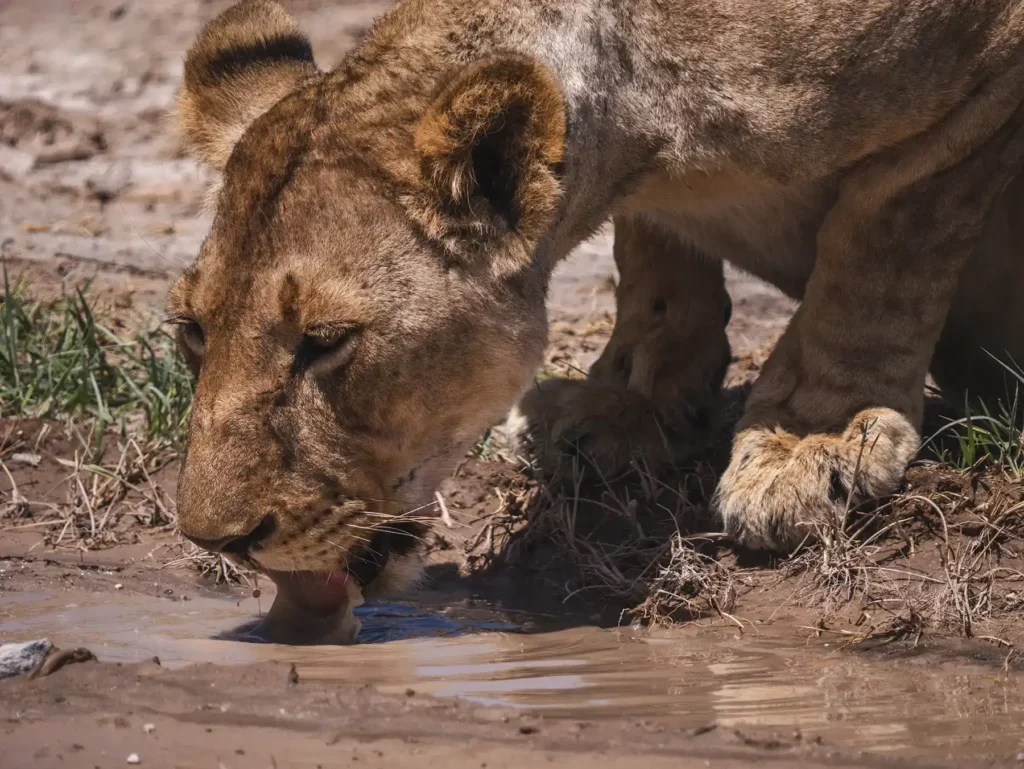
My Experience Visiting Amboseli National Park
If any park in Kenya really exceeded my expectations, I’d have to give the award to Amboseli. This fantastic park was simply teeming with wildlife and I got to see something new every day.
Amboseli is known for its huge herds of elephants, but it’s hard to imagine the scale of them until you see them marching across the plains with their giant tusks. Seeing a tiny, tiny baby elephant (so so cute!) and two juvenile male elephants sparring was also a huge bonus.
Since the elephants migrate to and from Amboseli’s central marshes every day, you can easily find them here by going first thing in the morning. Sometimes they were so close that I could hardly believe it. On a clear day, seeing hundreds of elephants with the view of Kilimanjaro mountain in the background is magical.
Other fantastic sightings I had here were seeing three cheetahs hunting one morning, alongside a wonderful sighting of a pride of lions, chilling in their den with their young cubs. I also saw many giraffes, zebras, impalas, gazelles and water birds.
On my most recent trip, I stayed at Tulia Amboseli Camp and couldn’t recommend it enough. They grow fresh fruit and veg in the garden which the chefs turn into fantastic meals, and I could take a dip in the plunge pool on our deck in the evenings – perfect after a full day out on safari. It’s now one of my favourite camps in East Africa!
You can watch a video of my experience visiting Amboseli National Park below.
Day 10: Amboseli to Tsavo West National Park
Total drive time (excluding game drives): 5 hours
It’s time to venture out to the last “big” nature reserve on this itinerary; Tsavo West,
Part of the much larger Tsavo National Park, this park is famous for its wildlife and stunning scenery. While you’re there, you have a good chance of seeing elephants, hippos, cheetahs, rhinos, leopards, and much more.
Itinerary
Today, you’ll make your way to another one of Kenya’s most beloved parks along the border of Tanzania. Although the drive is fairly lengthy, you may be lucky enough to have some great views of Mount Kilimanjaro.
Coming from Amboseli, you’ll enter the Tsavo West through the Chyulu Gate, arriving just in time for lunch and an afternoon game drive.
About Tsavo West National Park
Opening in 1948, Tsavo is Kenya’s oldest national park. And since it stretches an impressive 9,065 square kilometres, it also wins the title of Kenya’s largest park!
This sprawling safari destination is divided into Tsavo West and Tsavo East, separated by the Nairobi-Mombasa Highway. Most visitors tend to stick to Tsavo West, which boasts a myriad of activities and some incredible scenery ranging from desolate lava landscapes to tropical forests.
You can see all of the Big Five in Tsavo West and it’s particularly good for spotting leopards who like the woodland habitat.
Some of the most prominent natural landmarks in Tsavo West include the central Mzima Spring, the Shetani lava flow in the west, and Lake Jipe and Chala in the southwest.
These diverse landscapes support more than 1,000 different plant species, which become the food, shelter, and nesting sites for Tsavo’s diverse wildlife.
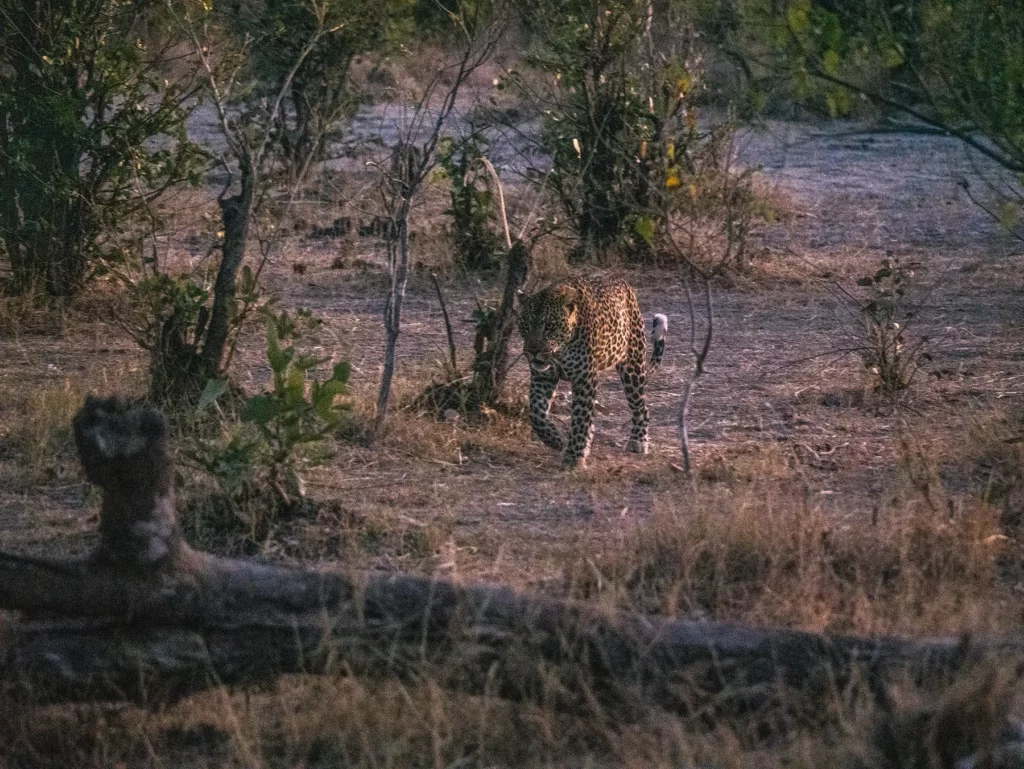
Where to Spend the Night
There are many places to stay both in and near Tsavo West. As there are camps on all sides of the park, try to pick one that is closest to a gate while still being within your budget and preferences.
You’ll be spending the following afternoon and evening hanging out at the lodge, so you may want to splurge a bit on this one or book something a little special for your last few nights on safari.
Tips for Visiting Tsavo West National Park
The best, and only, time to visit Tsavo West is during the dry season, particularly between June and October. Once the rainy season begins, the road can become impassable. This can happen surprisingly quickly.
If you are visiting at the tail end of the dry season, make sure to call the park yourself or have your guide do it to ask about road closures. If too many roads are closed, you may not be able to have a safari there and you’ll need to remove it from your itinerary. I found this out the hard way so don’t make the same mistake!

Day 11: Tsavo West National Park
Total drive time (excluding game drives): 0 hours
Get ready for an amazing morning of animal sightings followed by a restful afternoon back at the lodge. Tsavo West is one of the best places in the world to see black rhinos, so make sure to keep an eye out for them as they can be hard to spot.
Itinerary
Rise and shine for your last game drive in Kenya. You’ll head out bright and early for a morning game drive, before returning to the lodge in the afternoon for a filling lunch and an afternoon of relaxation.
Where to Spend the Night
You’ll be staying at the same lodge as the previous night which means no packing or unpacking today!
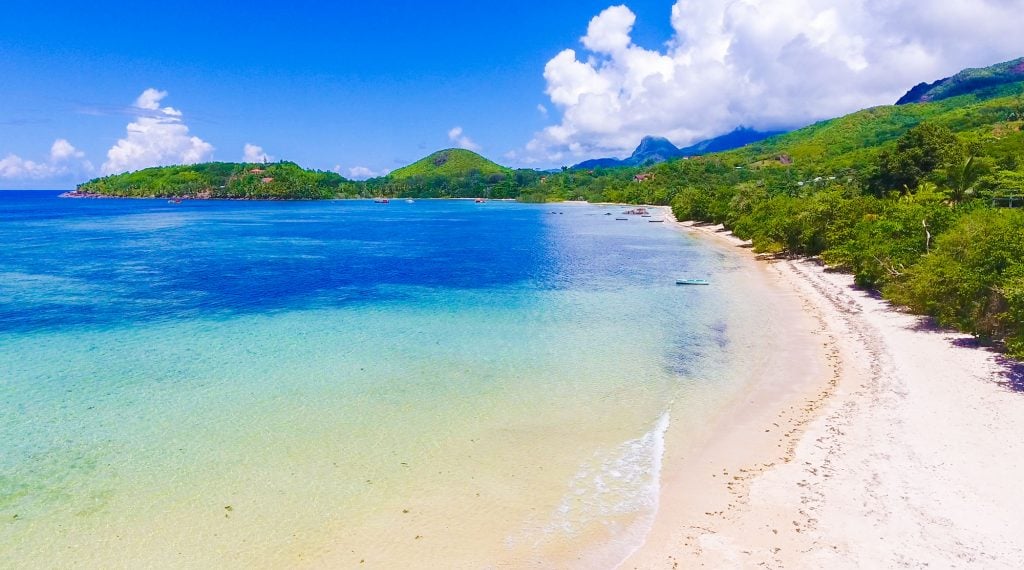
Day 12: Tsavo West to Diani Beach
Total drive time (excluding game drives): 5 hours
Are you ready to trade in savannahs for glittering beaches and palm trees?
After spending the past 10 days discovering Kenya’s spectacular wildlife, it’s time to go and see a very different side of the country!
Hopefully, this final stop will give you the chance to kick back and relax before you start making the long journey back home.
Itinerary
Today, you’ll drive around 5-hours from Tsavo West to Diani, located at Kenya’s southeastern tip.
If you leave early enough, you can spend the afternoon in Diani reconnecting with your inner beach bum, going snorkelling in the crystal clear water, or simply grabbing a few cocktails at one of the beach bars.
After following this itinerary, you are likely in need of a break so take some time to enjoy the laid-back charm of this quintessential beach town – you’ve earned it!
Alternatively, if you consider yourself more of a city slicker, you can always go check out Mombasa instead, Kenya’s second-largest city.
Mombasa is also an interesting stop for history lovers; it was once an important trading post for the Indian Ocean trade and served as the capital of Kenya during the British occupation. You can see vestiges of this long history around every corner.

About Diani
Diani is the top tourism destination along Kenya’s South Coast thanks to its white sand beaches, and warm, calm water. It’s the perfect spot for water sports such as jet skiing, stand-up paddleboarding, snorkelling, scuba diving, and kitesurfing.
Diana is considered to be one of the best beaches in Kenya and is located just 30 km south of the port city of Mombasa.
Where to Spend the Night
Diani Beach is backed by a line of resorts, guest houses, and restaurants. There are many different options for accommodation including boutique hotels, vacation homes, and sprawling beach resorts. You can find a wide range of prices up and down the beach so I am sure that you’ll find something that’s perfect for you.
If possible, I recommend staying in one of the beachfront properties so that you can enjoy the gorgeous beach views.
Tips for Visiting Diani
The sun is strong so make sure to wear plenty of sunscreen.
Where possible, time your visit for calm seas and clear water. The best months are December to March and July to October, when visibility for snorkelling and diving is excellent and seaweed is minimal.
Use reef-safe sunscreen and water shoes as coral and urchins are close to shore in places, so footwear protects your feet while helping preserve the fragile reef ecosystem.
If you fancy keeping active you can take day trips to Kisite-Mpunguti Marine Park for dolphin spotting, or visit Shimba Hills National Reserve (about an hour away) to see coastal forest wildlife and Kenya’s only sable antelopes.
Like with all towns, avoid walking on your own after dark.
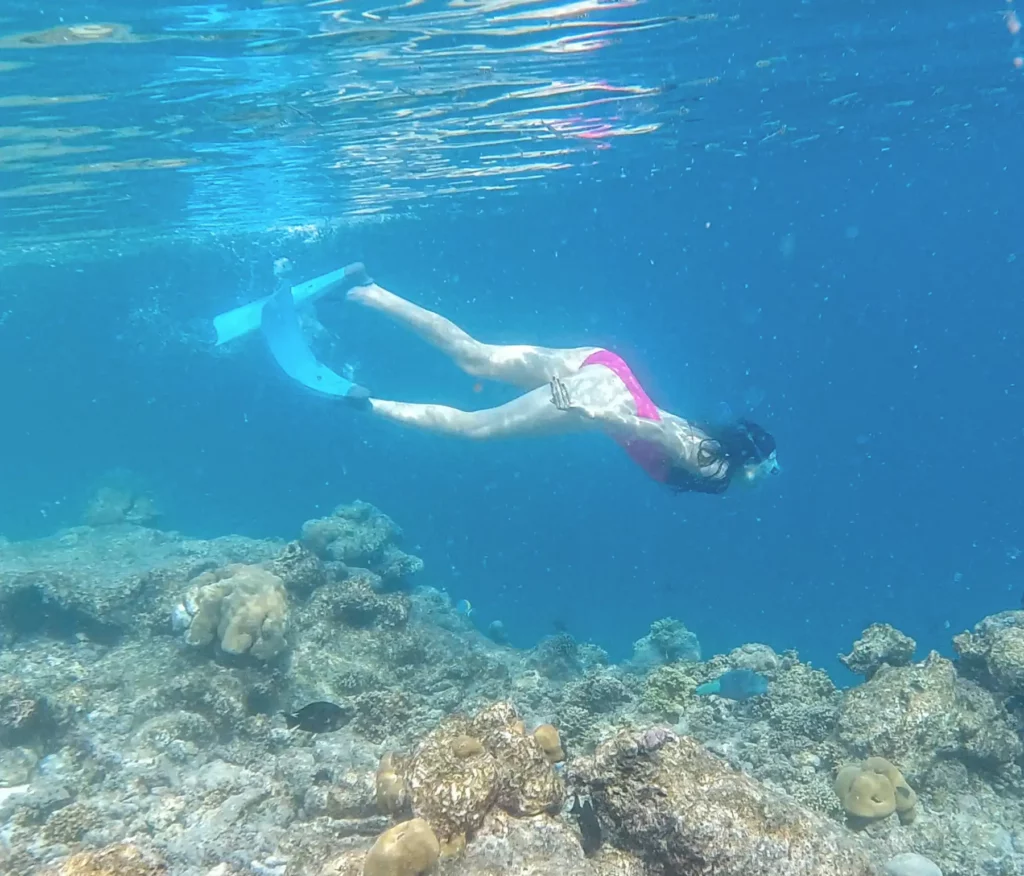
Day 13: Diani Beach
Total drive time (excluding game drives): Dependent on what activities you decide to do.
Spend your final day relaxing on the gorgeous beach or exploring just offshore.
Things to Do in Diani
Diani is the perfect place to finish off any Kenya vacation. The glistening Indian Ocean, powder-white sand, and relaxed vibe provide the perfect setting for your last full day.
Below are just a few ways to spend a day here:
1. Relax on the Beach
Diani’s soft white sand is hard to resist and I certainly wouldn’t blame you if you decided to spend the entire day sunbathing.
2. Go Snorkelling
Diani is lucky enough to be surrounded by coral reefs and the warm water of the Indian Ocean makes it an irresistible place for snorkelling. The best snorkel spot is Nomad Beach, just in front of Nomad Beach Bar & Restaurant.
3. Eat at One of Diani’s Delicious Restaurants
After spending the last 10 days eating picnic lunches from the safari lodges, you may be in the mood for a few mouthwatering meals! Diani offers tons of different options for hungry visitors, ranging from high-end seafood restaurants to chilled-out cafes.
You can’t go wrong with a visit to Nomad Beach Bar & Restaurant which serves up good-quality local and international dishes and offers sweeping beach views. Loved by locals and tourists alike, this place is practically a Diani institution.
If you are looking for something unique, head over to Ali Barbour’s Cave Restaurant; this eatery is situated in the middle of a natural cave!
4. Shimba Hills National Reserve
If you aren’t quite ready to say goodbye to Africa’s wildlife, visit Shimba Hills National Reserve. Rich in flora and fauna, this is one of the largest coastal forests in East Africa. Game drives within the reserve offer sightings of elephants, hyenas, giraffes, leopards, waterbuck, and more.
The reserve is only a 30-minute drive from Diani, so you can easily spend the morning on a game drive and then the afternoon on the beach.
5. Colobus Conservation Centre
This non-profit organisation is dedicated to conserving the rare Colobus monkey. The centre offers guided primate eco-tours that allow visitors to see colobus monkeys, vervets, sykes, and baboons.
After the tour, visit their information centre to learn more about their ongoing conservation activities.
Where to Spend the Night
You’ll be staying at the same hotel or guest house as the previous night.
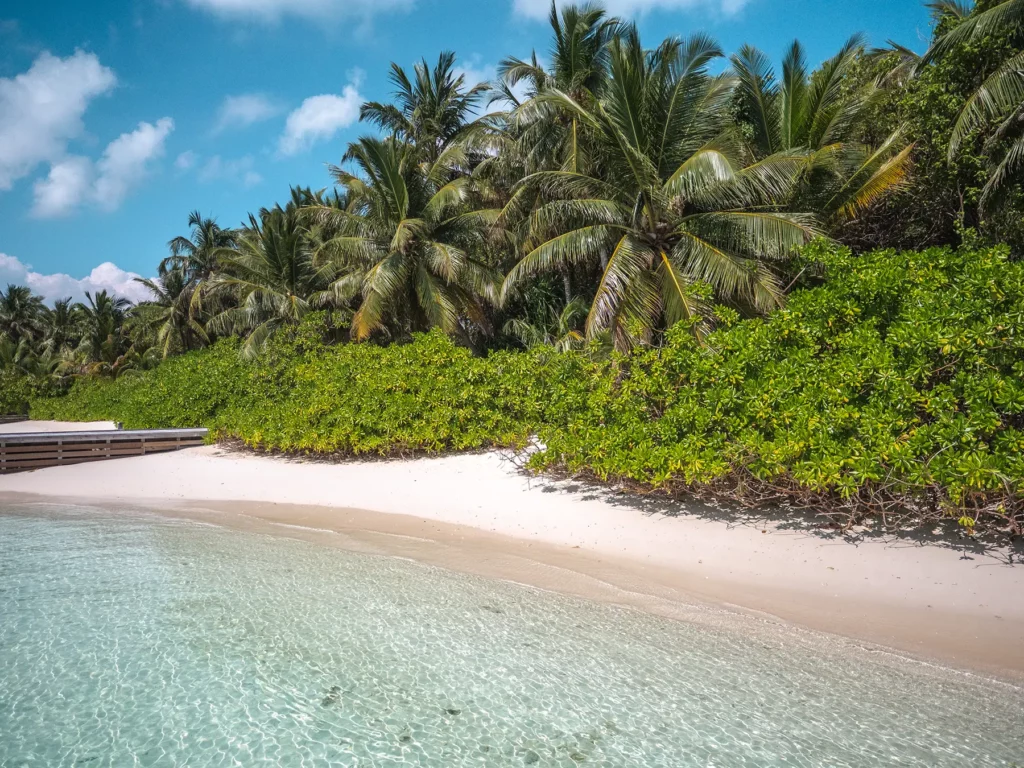
Day 14: Diani Beach to Nairobi
Total drive time (excluding game drives): 10 hours or a 1-hour flight
Today will be your last day in Kenya and I am sure that you have had a blast so far!
There are two options for getting back to Nairobi, both of which have some pros and cons. I have listed both options here, so choose the option that works best for you!
Itinerary
To finish off your trip, you can either do a full-day drive back to Nairobi or hop on a one-hour-long flight.
If you go for the flying option, you can spend the morning relaxing in Diani before taking an afternoon flight, or take a morning flight and spend the afternoon exploring Nairobi.
If you decide to drive back to Nairobi instead, you will retrace your steps back up the Nairobi-Mombasa Highway towards Chyulu Hills National Park.
It’s pretty much a straight-shot drive from Mombasa to Nairobi on a paved highway, making it a relatively easy, but very long, drive. As always, leave as early as possible so that you can avoid driving in the dark.
Recommended Booking Options For Your 2-Week Kenya Itinerary
Private Safari
Most popular & best experience – typical prices for this itinerary start from $300 per person per day.
Visit safarisbyella.com for free quotes from trustworthy local tour companies I use to book my own trips.
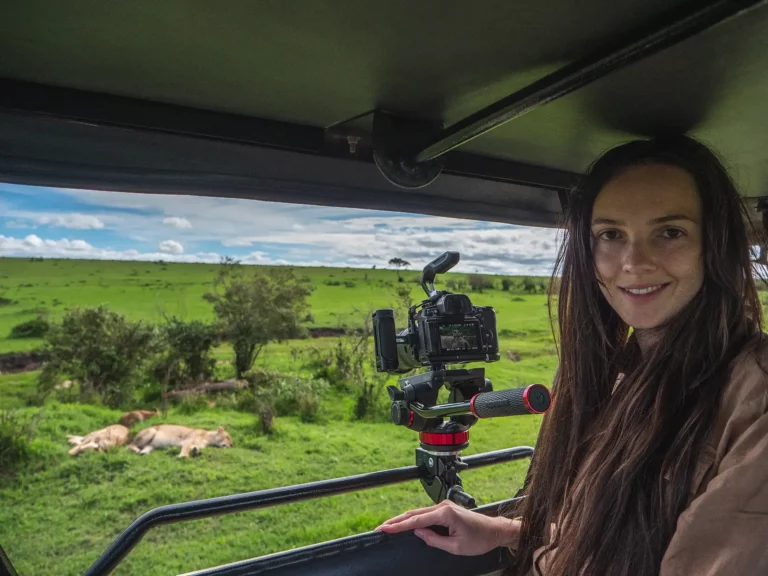
I could not find any group safaris following this or any similar itineraries. See my guide(s) below for better group budget options.
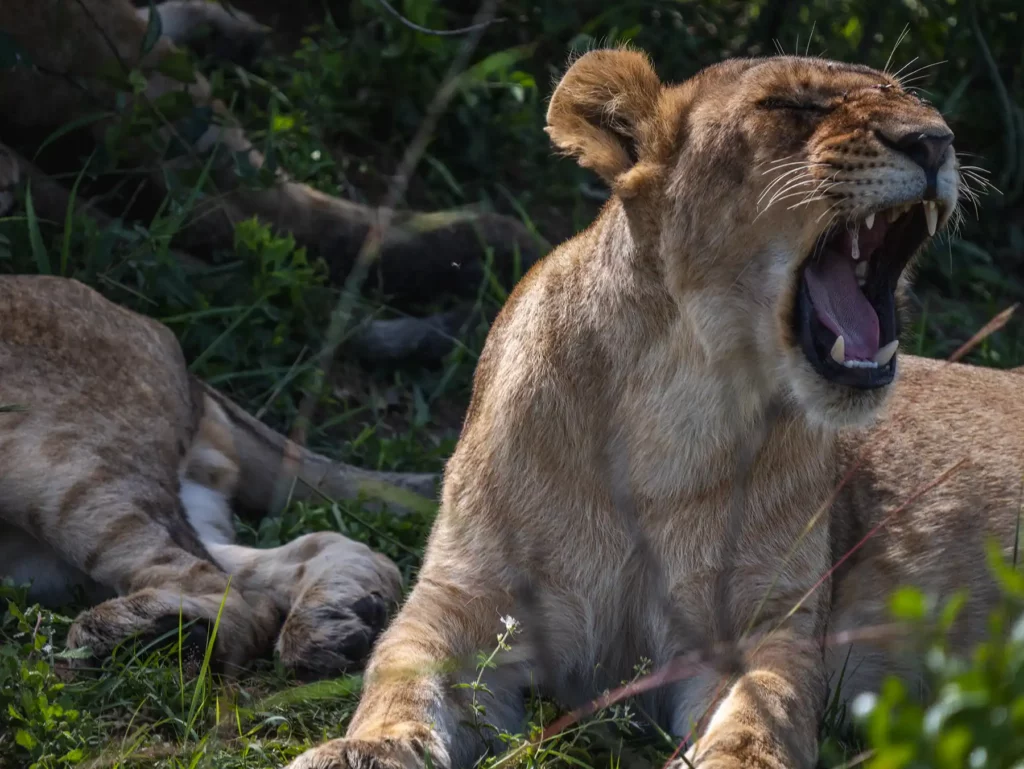
Final thoughts
Honestly, you can’t beat Kenya when it comes to having a fantastic African safari. The country has so many fantastic national parks and reserves. And with so much incredible wildlife to see, it’s no surprise that Kenya has been home to some of my favourite safari experiences!
A 14-day safari allows you to visit many of Kenya’s highlights. Visiting the Masai Mara and Amboseli alone will give you some wonderful safari experiences, but adding Ol Pejeta and the two lakes to the mix truly allows you to appreciate the scope of the wildlife here.
And there really couldn’t be a better way to finish off a Kenya holiday than visiting Tsavo West before heading to the stunning beaches of Diani! Not only does this coastal area show you another side of the country, but also allows you to relax in paradise and finish your trip on a high!
I hope this post has helped you plan your dream trip to Kenya. If you’re still undecided on where to go on your African safari, you may be interested in reading my 7-10 day Tanzania safari itinerary. Tanzania is right next door to Kenya and similar in cost. Both have something unique to offer and either is a brilliant option for your trip!
Read More Kenya Guides
Kenya Itineraries
Recomended itineraries and how to book them.
7-10-Day Kenya Safari Itinerary
3 Day Kenya Safari Itinerary & Costs
2-Week Kenya Safari Itinerary & Costs
Kenya & Tanzania Itineraries
Multi-country itineraries and how to book them.
10-Day Kenya and Tanzania Safari Itinerary
2-Week Kenya & Tanzania Safari Itinerary
Costs & Planning
How to get the most bang for your buck and the best time of year to visit depending on what you want to do and see.
Kenya Safari Costs – Everything you Need to Know
The Great Wildebeest Migration Guide
National Parks & Reserves
Complete guides to the best and most famous safari reserves, including the wildlife you’ll see, entrance costs and best time to visit.
Coming soon.
Other Popular Safari Destinations
How to Book Your Safari
Save time and ensure an incredible safari experience by getting quotes from my recommended local safari companies.
Join the rapidly growing tribe of over 1,000 travellers who’ve booked their dream safari using my insider tips and recommendations.

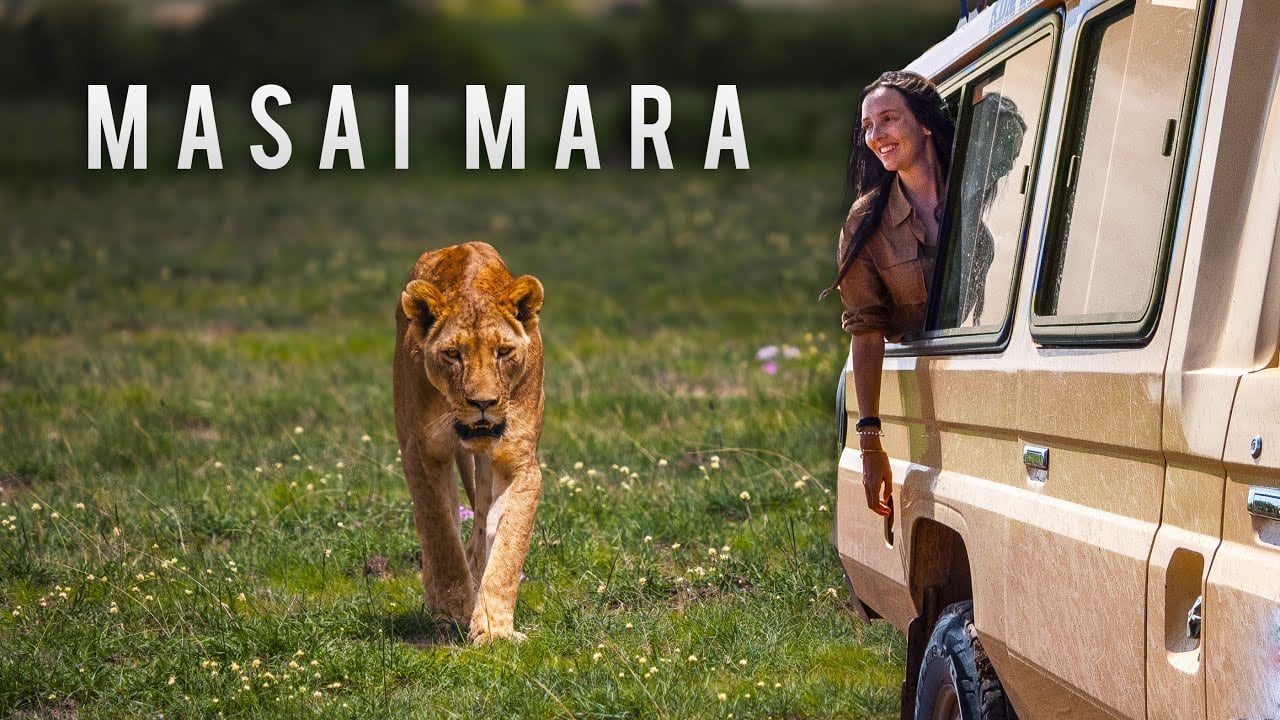
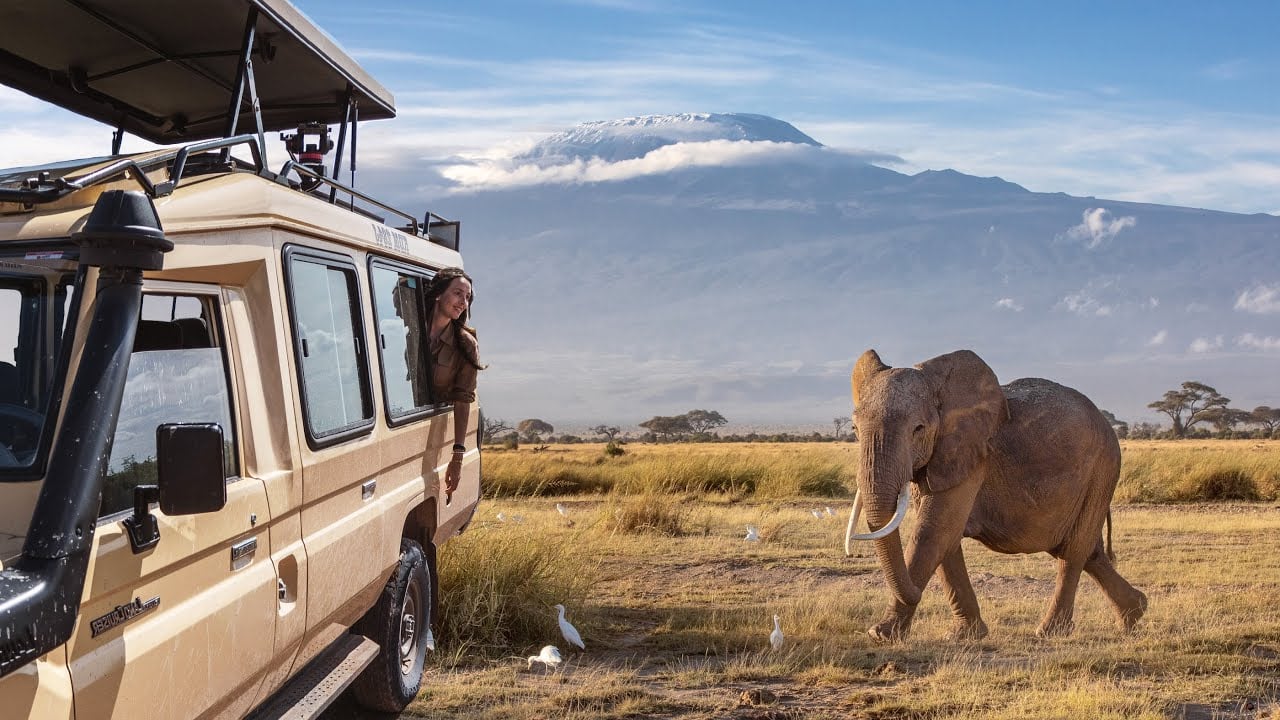
This is so so helpful.
I’m visiting friends, they have lots of ideas and this detailed overview of how to plan time will be useful.
I want to explore the opportunities for train travel